
#170
April 2024
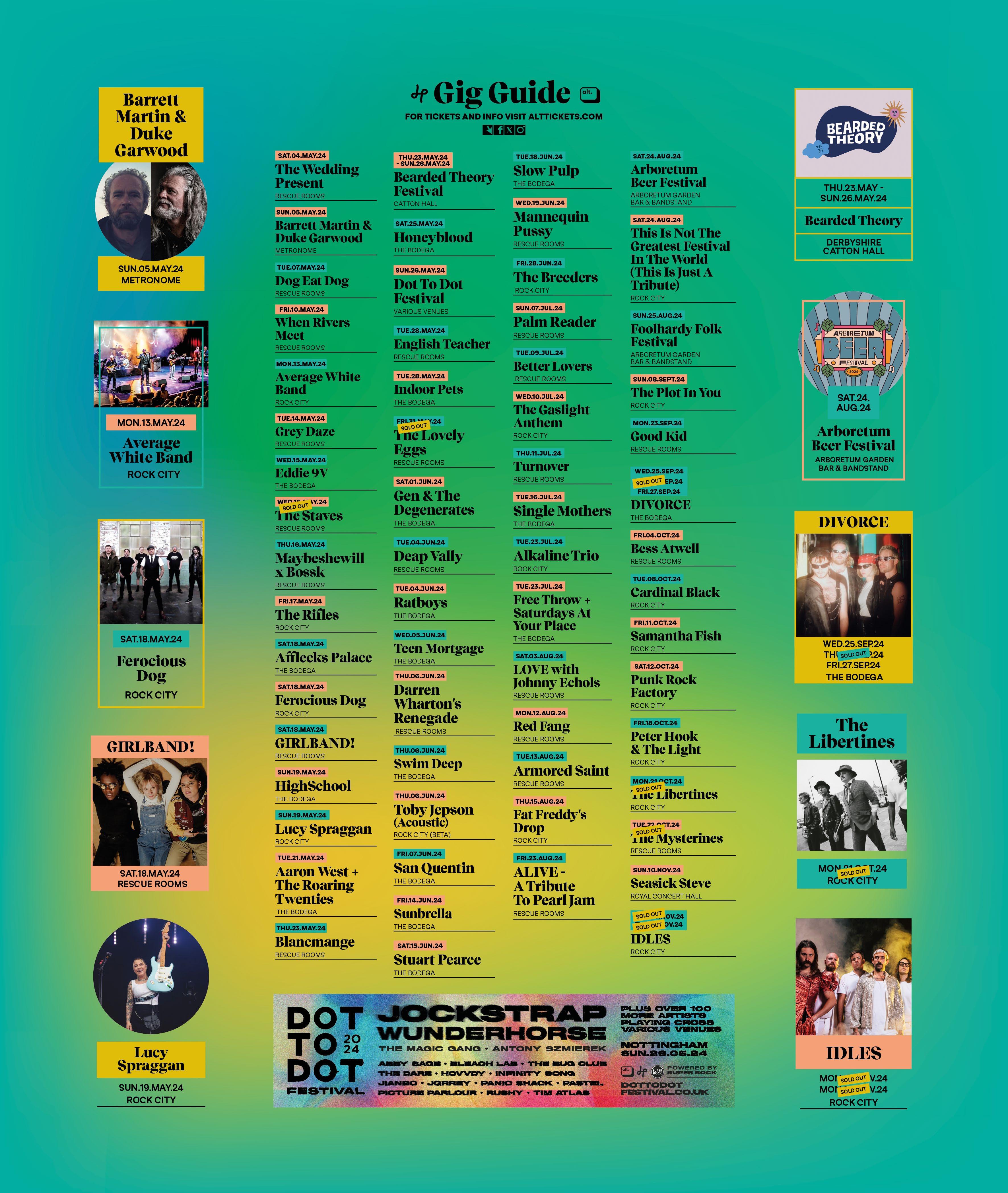

Credits

Ethere-Al Alan Gilby (alan.gilby@leftlion.co.uk)

Head Designer Natalie Owen (natalie.owen@leftlion.co.uk)

Music Co-Editor Gemma Cockrell (music@leftlion.co.uk)

Stage Co-Editor Ian C. Douglas (ian@leftlion.co.uk)

Community Editor Rose Mason (community@leftlion.co.uk)

Literature Editor Andrew Tucker (literature@leftlion.co.uk)

Editor-in-Chief Jared Wilson (jared.wilson@leftlion.co.uk)

Partnerships Manager Adam Pickering (adam.pickering@leftlion.co.uk)

Music Co-Editor Maddie Dinnage (music@leftlion.co.uk)

Stage Co-Editor Dom Henry (dom.henry@leftlion.co.uk)

Food Editor Julia Head (food@leftlion.co.uk)

Photography Co-Editor Dani Bacon (photography@leftlion.co.uk)

Environment Editor Eleanor Flowerday (environment@leftlion.co.uk)
Cover Rebecca Evans
Editorial Interns
Freddie Stringer
Louis Clevett
Alfie Beswick
Writers
Richard Minkley
Jay Sandhu
Zach Bromberg McCarthy
Nadia Whittome
Diala Isid
Phil Taylor
Peter Hillier
Benjamin Weare
Rachel Jackson
adVertise WitH us

Editor Sophie Gargett (sophie.gargett@leftlion.co.uk)


Fashion Editor Addie Kenogbon (fashion@leftlion.co.uk)
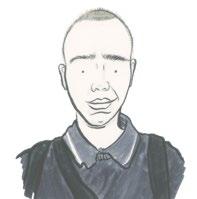
Featured Contributor
Cameron Black
Sam Marshall
Louis Dargavel Corbett
Martin Makowski
Claire Jones
Cara Thompson
Photographers
Louise Sugden
Stewart Bywater
Chris Baker
Martin Makowski
Timmy_Fooduk
Paul Dennan
George Brumpton
Kinga Gogolewska
Lindsey Fletcher
Peter Taylor
Would you like to advertise your business or event in LeftLion? Email partner@leftlion.co.uk to discuss available options.

Screen Editor Oliver Parker (oliver.parker@leftlion.co.uk)

Photography Co-Editor Fabrice Gagos (photography@leftlion.co.uk)

Art Editor George Dunbar (art@leftlion.co.uk)
Distribution Dom Martinovs
Vikas Sandhu
Helen Woods
Nottingham University Museum
Polydor
School of Artisan Food
Alice Ashley
Fashion Revolution
Carcanet Press
Alan Parkinson
Illustrators
Jim Brown
Lily Keogh
Kathryn Cooper
Toby Anderton
Zarina Teli
Web Developer Tom Errington (tom.errington@leftlion.co.uk) leftlion.co.uk/issue170

You’ll find Dani most likely wearing a beret, clutching a janky looking film camera and talking about her cats or her zillions of unrealistic aspirations. She might be on her way to a Magazine Journalism MA class at NTU, working at her Beeston photography studio ‘The Pigeon Loft’, doing an art class, drinking coffee at Blend or at home watching The Lord of the Rings.
Dani first moved from Norwich to Nottingham in 2013 to study photography at NTU. She began contributing during the second covid-19 lockdown with the introduction of ‘Shower Thoughts’ and has since been a frequent writer. Using her photography skills, she has shot multiple portraits for features over the years and just last month she was delighted to become the new LeftLion co-photography editor.
supporters
These people #SupportLeftLion
Alison Gove-Humphries, Alison Hedley, Alison Knox, Anamenti, Ant Haywood, Audrey & Lizzy & Margot, Barbara Morgan, Cerys Gibson, Chris Jarvis, Chris Underwood, Claire Foss, Clare Foyle, Colin Tucker, Cyra Golijani-Moghaddam, Dan Hemmings, David Knight, Dick Watson, Dominic Morrow, Donna Rowe-Merriman, Eden PR, Emilija O, Erika Diaz Petersen, Graye Wilde, Harry Sutcliffe, Harry Turner, Hayley Howard, Hazel Allister, Heather Oliver, Holly's Merry Moggies, Ian Carroll, Ian Phillips, Ian Storey, Ian Yanson, James Place, James Verran, Jane Dodge, Janine Lees, Jean Forsey, John Haslam, John Hess, John Holmes, John & Jackie Scruton, Jonathan Day, Joshua Heathcote, Julian Bower, Justyn Roberts, Katherine Sanders, Kathleen Dunham, Kay Gilby, Kiki Dee the Cat, Lilian Greenwood, Livi & Jacob Nieri, Louise Duffield, Marc Weaver, Mark Barratt, Mark Bond, Mark Gasson, Mark Jacobs, Miri Debah, Monica White, Nigel Cooke, Nigel King, NottingJam Orchestra, Paul Boast, Pearl Quick, Philip Renshaw, Rach, Rachel Ayrton, Rachel Morton, Raphael Achache, Redbrick Communications, Richard Goodwin, Rob Arthur, Roy Manterfield, Russell Brown, Sam Hudson, Sam Stiling, Sarah Manton, Selectadisc, Simon Evans, Steve Benton, Steve Holland, Steve Lyon, Steve Wallace, Sue Barsby, Sue Reader, Tracey Newton, Will Horton
Fancy seeing your name (or the name of your band, small business, loved one, pet etc) in this mag every month? It only costs a fiver and the money supports this magazine. Plus you get all kinds of other treats too.
patreon.com/leftlion



@leftlionmagazine leftlion @leftlion
4

Full Circle
Local star Holly Humberstone discusses her rising fame, overcoming stage fright and the unique sound on her new release
Chef’s Kiss

Master of Puppets
After twenty years as Zippy’s puppeteer, Ronnie le Drew talks about his life on Rainbow ahead of his Nottingham show
We went down to the School of Artisan Food, an exquisite hands-on cooking experience nestled in the north of Notts
A Palestinian in Notts Nottingham resident Diala Isid shares her story of starting a running group in Palestine and the importance of the right to movement
Just The Ticket
Managing Director Tom Morgan explores the past and present of trentbarton busses after being part of the community for over a century
35 Years Later
A nuanced look into the Hillsborough disaster, the depths of survivors guilt and hidden trauma that still lingers
Going Rogue
Hardcore Warhammer hobbyist, Louise Sugden talks about her thriving Youtube channel, the industry’s roots in Nottingham and miniature-making as an art form


Greetings intrepid picker-uppers of print, and welcome to our April edition of LeftLion. We made it to Spring Equinox, the blossoms are blooming, we time travelled an hour ahead, and we’re already a quarter of the way into 2024phew! If we don’t get some of that bright spring weather soon however I’m thinking of writing a strongly worded letter to the weatherman to see if they can pull some strings in the sky. (If you are reading this on a beautiful day - hurrah, it worked!)
We’ve got a lovely bumper collection of stories for you this month, accompanied by some mighty fine illustrations too. I was beaming when Toby Anderton’s excellent depiction of Zippy and puppeteer Ronnie le Drew appeared in my inbox, not to mention reading Ronnie’s fascinating behind-the-scenes stories of Rainbow (p. 21). We heard from two important local voices regarding the current situation in Palestine (p. 16) and a retrospective on the Hillsborough disaster and its lingering reverberations today (p. 26). We also got the scoop on the newly reopened Sherwood

Architects of Awe
The luminarium is a world-class sensory experience made right here in Nottingham, providing immersive wonder from children to grandparents alike
Funneh Talk
Linguistics professor Natalie Braber helps us get to the bottom of what makes the Nottingham accent so unique, and why ‘cob’ and ‘mardy’ are not going out of fashion anytime soon
Farm-to-Fork Fare
After almost losing their farm, Restaurant Jericho owners Rich and Grace Stevens had to get creative and are now reshaping kitchen etiquette
Swap Shop
We talk to the founder of The Sherwood Exchange where you can donate and swap your surplus items and do your bit to reduce waste
Naut Better
Local rapper Juga-Naut lets us in on how he blended lyrics and meaning, production and collaboration, to create his stunning record, Bem II.
Out of Time: Bendigo
A deep-dive into William ‘Bendigo’ Thompson’s rags to riches story from Nottingham slums to country-wide fame
Exchange, where you can do your bit for the environment by donating your surplus items and swap them for other goods (p. 37). I shall definitely be nipping down for a gander one Saturday!
Finally, I was once again floored by the gorgeous cover art this month from artist Rebecca Evansone of those illustrations that reveals new details the more you look at it, and definitely one I’ll be framing for my wall. Read our interview with Rebecca on the next page!
Now I suggest you move your seat into the reclining position, find yourself a pint or a pet to chill with, and take a bit of time out to be a human being rather than a human doing. Until next time,

5 leftlion.co.uk/issue170 Contents editorial leF tlion in tHe Wild LeftLion Ltd is a carbon neutral company, having reduced our direct emissions by 99% since 2018. We offset the rest via direct air capture from Climeworks. LeftLion Magazine is fully recyclable and compostable, made from recycled or FSC® certified (C015932) sources, and printed using renewable energy. The emissions of this paper are offset via the World Land Trust. 12 24 21 15 26 16 22 34 44 37 CBP012610 41 28 31 Sophie Gargett
for treats Q @ohvirago
us on Instagram @leftlionmagazine to feature your picture in a future issue.
Posing
Tag



UNDERCOVER ARTIST - Rebecca Evans

Tell us a bit about yourself…
I am a part-time illustrator, part-time Library worker and full-time bibliophile. I was born in Surrey to a family of Londoners so unfortunately I’m about as southern as it gets! I followed my sister to Nottingham in 2019 after I found the cost of living in London was becoming pretty stifling and I have honestly never regretted it. Moving here has given me the space and freedom to be the creative, book-worm, cat-mum that I always aspired to be.
What was the inspiration behind the cover?
The main visual reference is obviously the Wizard of Oz I felt like it was a really good visual metaphor for what Nottingham has become to me, as well as being a nice analogy for the month of April when we first start really stepping out of the grey and dark of winter and start to see colour coming back to our environment with bulbs and blossoms starting opening up. There are references to some of my favourite things and places in and around Nottingham, as well as some of the things it’s most famous for. My cat, Florence (or Flo-Flo as her friends call her) even appears as my Toto stand-in, mostly because she is the only one of our cats that would actually let me pick her up in real life.
Pick Six
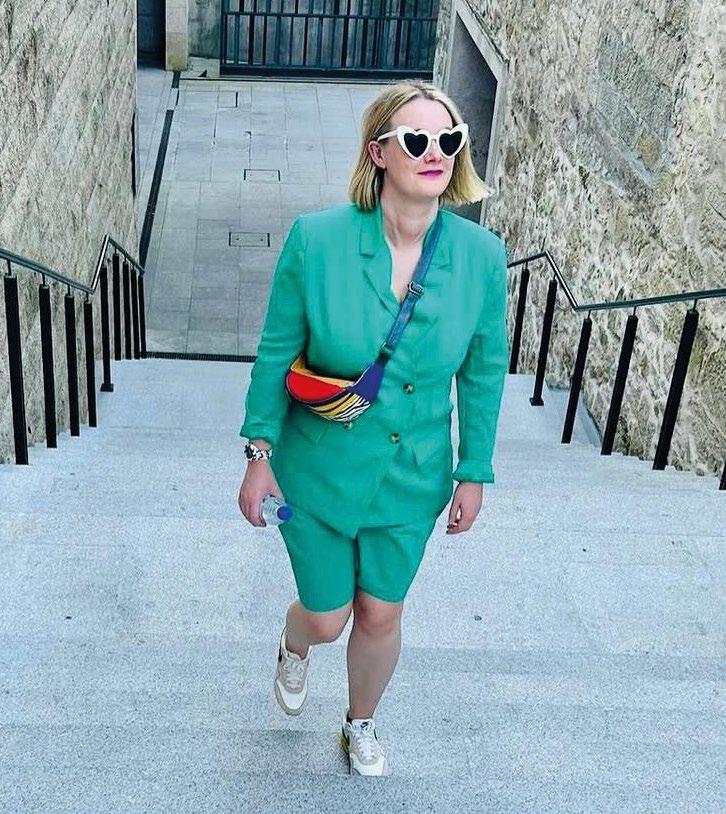
This month we turned to the colourful, creative Izzy Bradley, General Manager at Architects of Air, which you can learn more about on page 24!
How does it compare with some other projects you’ve worked on?
I’ve really only just started seriously putting my work out into the world for other people to see so this is definitely the most nerve-wracking project so far- there’s really nowhere to hide when it’s on the front of a magazine!
What was the biggest challenge that you faced in creating the piece?
I was given carte blanche with it which was super exciting and inspiring… but then I am faced with a piece of paper full of scribblings of ideas and have to pick one! One thing I have learnt about myself as a creative is that my first idea is usually the strongest even if it’s initially the least developed. There’s always the nagging doubt that I went with the wrong one, but to be fair that isn’t unique to this piece!
Tell us about some projects you’ve worked on in the past…
My work is really inspired by the things I read- mostly fiction and poetry. Unfortunately I’m not a great writer (evidently!) so my way of responding to the inspiration I get from these things is to draw. Pretty much everything I’ve made in the past has its basis in literature or storytelling. What have you got planned for the future?
At the moment I am working on a self-directed series of twelve book cover designs of 20th Century novels, one for each month of the year, that you can see on my Instagram. Towards the end of the year I hope to turn them into a 2025 calendar. Cover design and book illustration are my dream projects, so I figured I would set myself a little pretend brief in the meantime!
Is there anything else you’d like to tell the LeftLion readers?
My favourite maybe true historical fact is that Mozart and Marie Antoinette had a pretend wedding in her playroom when they were children. That’s the most interesting thing I can ever think of to say at parties.
Find more of Rebecca Evans’ work via her website: rebeccaevans.myportfolio.com
Q @raeillustration

Film - Wizard of Oz
My all time favourite movie. Even now, I find the jump from the black and white to technicolour absolutely marvellous and I can only imagine what it was like to watch this in the cinema when it was released in 1939. Rainbows, ruby shoes, yellow brick roads, emerald city - I think this movie is the reason I love colour so much. It’s got everything - drama, magic, surrealism, a pinch of scary, friendships, desire for adventure and the poignant message of “there’s no place like home”.



You know what? I think rattlesnakes are given a really hard time
Song - Three Lions ‘96
Very hard to pick as it completely depends where I am, who I’m with and what mood I’m in. But I’m going for Three Lions ‘96 - not necessarily for the song itself but the atmosphere when I hear and sing it. Full of anticipation, raw emotion, nostalgia and hope; I’ve screamed this song at the top of my lungs since I was seven years old at every opportunity. I’ve loved watching the evolution of the women’s game in this time - finally bringing it home in 2022!
Holiday destination - Japan
The best day of my life was visiting Naoshima - a small island known as the mecca for contemporary art and best known for hosting Yayoi Kusama’s Yellow Pumpkin. Full of galleries, museums, architecture, sculptures and the Art House Project - immersive and site-specific art scattered around a small town. The island is so small you can cycle around it in a day, visit a public bath full of art, eat in family-run restaurants and sleep in a Mongolian yurt on the beach. Glorious!
‘School shootings are fine but…’ (the rest was inaudible)
You're pragmatic, but you're socially inept. It's good. You know that bald man with the wonky bush…
How can I love my neighbour when he wears socks and Greggs sliders
Kid 1: Fam, this cereal is dry as!"
Kid 2" Innit, Tesco got the dryest cereal, proper dry tings"
My 3-year-old after getting an accidental wedgie: "Does Mummy like things up her bottom?"
Woman 1: Stop putting your toe in my bum.
Woman 2: I'm not, you're putting your bum on my toe!
You don't find a wife in Rock City. Go to temple to find wife.


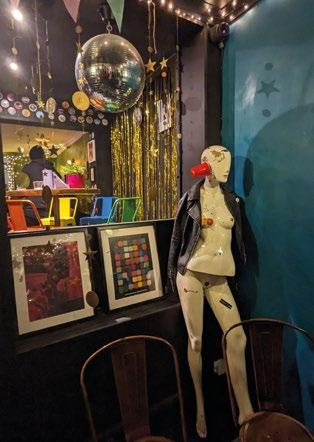
Book - The Story of Art Without Men
I’m not a huge reader but after following @thegreatwomenartists on instagram celebrating women artists, I can’t wait to get stuck into The Story of Art Without Men by Katy Hessel which was gifted to me from a wonderful friend. A book turning the limelight on women artists creativity and telling the history of art as it's never been told before… right up my street!
Meal - Sweet House Bakery
The best treats in Nottingham, with counters full of creative moreish tray bakes, cakes & cheesecakes with twists on classic confectionery. An independent young family business that started as a lockdown project with now two counters in Arnold & Colwick. So not necessarily a meal but the experience of eating their bakes to mark special occasions throughout lockdown was such a small joy. Would recommend grabbing a selection box and going for a picnic with loved ones!
Notts Spot - The Chameleon I am going to miss this place so much and I think it goes without saying what a loss this’ll be for Nottingham in so many ways. An eclectic space with a million weird and wonderful stories. So I just wanted to use this opportunity to say thank you and goodbye.
7 leftlion.co.uk/issue170
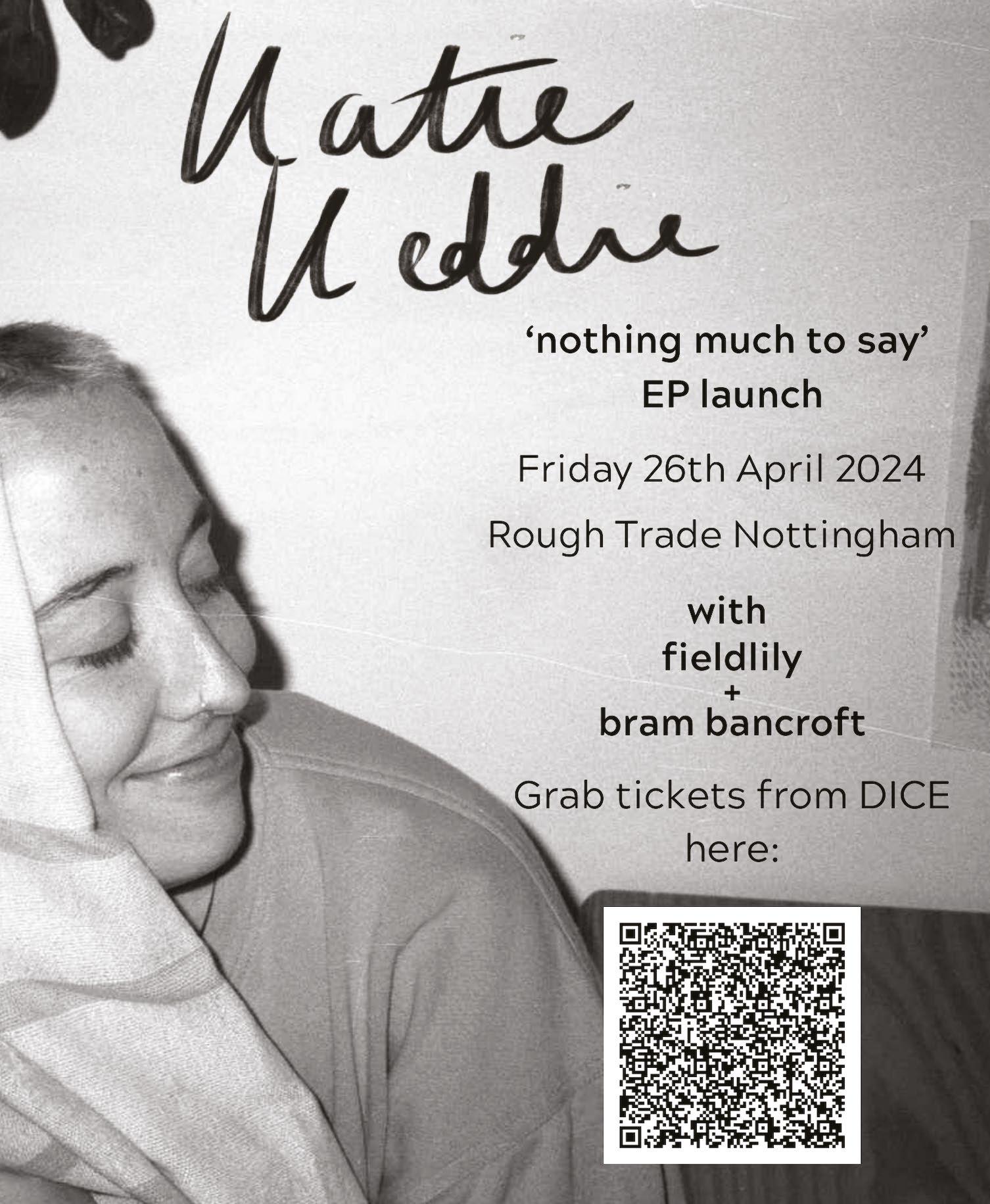
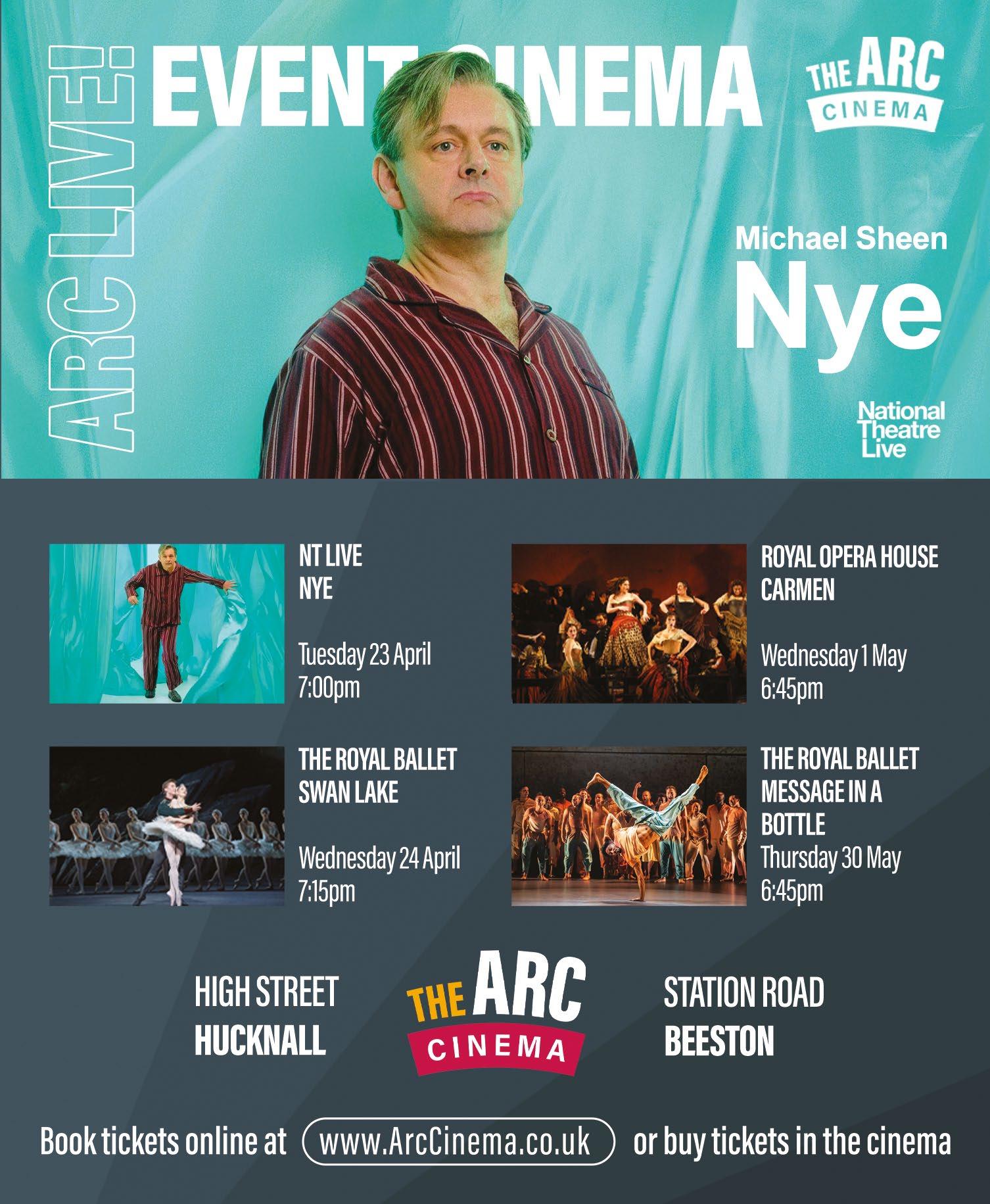

Poets Corner
Everything is Massive words: Cara Thompson
My bed’s a giant pritt stick.
The sheets are double sided tape. My eyelashes are paperclips And everything is massive.
The daylight is volcanic
And the air’s too big to breathe. My feet are two ton paperweights And everything is massive.
My doors on the horizon, handles fallen in the sea, my dirty whites hang off the cliffs of Dover. Everything is massive.
And my hair is made of static skin is wrapped around the moon. My weekly shower is a hurricane And everything is massive
In association with

And my garden looks Jurassic And the weeds all know my name And I envy their resilience when everything is massive And my telephone’s a time bomb And the loo is miles away And everything is massive And the world is in flames
And my friends are all Goliaths I wear stilts to feel the same. And I swear I’ll take this pain And turn it into something massive
But for now I’ll lay in pritt stick Under double sided tape Cause how much more can I expect to take When everything is massive?

Nottingham Poetry Festival takes place from 7-16 June 2024. nottinghampoetryfestival.com


Nottingham’s most opinionated grocers on...
April Fools
The Eggman, the man who supplies eggs to our shop, has a really good one. He lives on a big estate in Kimberley and lots of people walk their dogs past his dirt track at the bottom. He’s planted three or four very small conifer trees down there. But he’s also taken four of our leftover 10ft Christmas trees and on the night before he’s going to swap them over. That sudden growth should definitely raise an eyebrow among his neighbours.
Buses
There seem to be quite a lot of issues with Nottingham as a city at the moment, but one thing that always makes this city stand out from others is our buses. You can get from one part of the city to another quite easily and cheaply and it’s only really when you use the public transport in another city you come to appreciate that. They’re a lifeline to many people. However, we wish they hadn’t changed the colours of the city transport buses to reflect different routes. We much preferred the old corporation green, it was iconic.
Nottingham Puppet Festival
A whole festival of puppets? Would you believe it? We’re too old to remember Zippy from Rainbow, that show was after our time. We do remember Sooty and Sweep. Is Basil Brush coming? Boom Boom! In all honesty, we’re actually a bit scared of puppetsthey’re not really our thing, particularly ventriloquist's dummies. Although we thought War Horse was very good when it was at the theatre and that was done with puppets, right?
If the world already ended with the asteroid killing the dinosaurs, are we the postapocalyptic monsters?
words: Dani Bacon

9 leftlion.co.uk/issue170
Nadia on...
the cuts

In November of last year, every local councillor’s worst nightmare came true in Nottingham. With a £23 million budget gap, the City Council was forced to issue what’s called a section 114 notice - informing the government that its annual expenditure would exceed its income. The government reacted by imposing commissioners and forcing the council to accept a budget of sweeping cuts.
As expected, it was full of bad news. These included, among other measures, cutting more than 500 jobs, ending grants to art galleries and other cultural institutions, the closing of Colwick Park activity centre and cuts to care homes, community centres and libraries. On top of that, council tax was raised by 4.99%the maximum that’s legally allowed without a referendum.
Unsurprisingly, the announcements sparked anger across the city. A petition against the cuts, set up by the Resolve Nottingham campaign, was signed by nearly 12,000 people, including the iconic Vicky McClure. At the start of March, I met with the group after they delivered the petition directly to 10 Downing Street. But despite strong opposition from our community, the Tory government in Westminster has been unrelenting.
How did we find ourselves in this situation? The government likes to point to the City Council’s own missteps, such as the well intentioned, but ultimately failed Robin Hood Energy initiative. But although the losses, estimated at £38 million, were not insignificant, they’re dwarfed by the funding that the Tory government has cut from the City Council over the past decade. Since 2013, Nottingham has lost an average of £100 million a year. That’s £694 less funding per resident, every single year.
Despite having some of the highest levels of deprivation in the country (Nottingham places 11th for deprivation, out of England’s 317 districts), our city faced a worse funding squeeze than most local authorities. Its particularly low council tax base added to its woes: 80% of properties are in the lowest council tax bands (A and B) so it's harder for the council to raise as much money as other areas with more expensive properties. As a result, the City Council’s spending power is down 28% since 2010 - far more than the already devastating national average of 19%.
Meanwhile, in part because of the cost of living crisis and wider government cuts, demand for services is soaring: with increasing poverty, growing numbers of people in need of social care and a record number of homeless people in temporary
accommodation. The poorer a local authority, the more pressures it’s facing. In fact, homelessness and social care costs make up two-thirds of the council’s budget, and 90% of the overspend.
Nottingham is far from the only council that has struggled. In 2018, Northamptonshire County Council was the first local authority in twenty years to issue a section 114 notice. Since 2021, six more have done the same. Unless there is a significant funding injection, many more will follow. In fact, a quarter of all councillors in England fear that their council could be next. No wonder: councils keep being asked to do more and more for less and less. There’s only so long that this situation can be sustained for before one unexpected expense pushes them over the edge.
Since 2013, Nottingham has lost an average of £100 million a year. That’s £694 less funding per resident, every single year
“Stop council cuts” may not be the most inspiring of campaign slogans. Only around one in three Nottingham residents take part in local elections, and most people don’t spend a lot of time thinking about their local council. They just want their bins collected on time, their roads and parks to be looked after, their local services to function. Much of the council’s work is invisible - until things don’t get done. Then we all notice.
But the City Council’s job isn’t just dealing with litter and potholes, important as they are. Its tasks include anything from managing the bus service to supporting the local arts scene to providing youth services, holiday activities for children and school uniform support for low-income families - so many of the big and small things that enable our community to thrive.
We must not only oppose the latest cuts, but demand a reversal of previous ones too. Nottingham deserves modern and easily accessible libraries, world-class art galleries, well maintained green spaces, high quality social care, opportunities for young people and support for the most vulnerable. That’s what I’ve been calling for in Parliament and what, together with our community, I’ll keep fighting for. nadiawhittome.org
words: Nadia Whittome photo: Fabrice Gagos
leftlion.co.uk/issue170 10


11 leftlion.co.uk/issue170


FULL CIRCLE
Local star Holly Humberstone is on a high, and still rising fast. We caught up with her between tours to discuss her confessional songwriting, how she has gained confidence performing on stage, and why Nottingham is still so special to her.
When Holly Humberstone landed back in the UK after a thirteen date headline European tour, her wish was to return to Nottingham, a place which still feels like home despite her putting down roots in London. Born in the city’s Queen’s Medical Centre, and bred on the edge of Grantham, the limited nightlife there meant Humberstone found herself caught in Nottingham’s gravity as she sought out entertainment, particularly live music.
“I had lots of happy times in Nottingham,” Humberstone tells me, smiling as she remembers, before confirming she did sometimes meet her friends by the famous ‘left lion’ in Market Square. “It was half an hour for me on the train. It was where I spent most of my teenage years going out. I feel like the Nottingham music scene just had a lot to offer.”
“I feel like it’s really nostalgic to me,” she goes on, becoming increasingly animated. “I was born there and I just feel a really strong sense of belonging… My parents work for the NHS and they’re still working in and around Nottingham, so it’s very much a special place for me. I go back as much as I can. It’s filled with memories on every corner!”
Nights out in the city have provided material for several of Humberstone’s songs, fuelling those fond memories. “I write a lot about going out there,” she confesses. “I had a show at Rescue Rooms which was like my first proper Nottingham show, and I’ve got this song called Ghost Me on my album – I’ve had so many good times in Nottingham but I had this really strong memory after the Rescue Rooms show - we went and did karaoke and we sang Angels with Rob and my friend Lauren, and I put it in the song.”
That ‘Rob’ is Rob Milton, who became her collaborator and producer after the two became friends by way of the Nottingham music scene. This story is a great example of the circularity of many of Humberstone’s experiences.
“Weirdly, I grew up loving Dog Is Dead, a Nottingham band, and now I get to work with Rob who was the frontman. I made quite a lot of the early stuff on my first EPs in Rob’s basement in Nottingham,” she tells me.
Humberstone’s close friend Lauren is name-checked more than once on her debut album Paint My Bedroom Black, and the song which is named after her references what many regard as the city’s best live music venue too: ‘And if I could rewind to every Rock City night,’ the wistful line goes.
“I do write a lot about my youth and having fun and going to Rock City and stuff like that,” Humberstone explainsand when I ask her later where in Nottingham she would most like to play again, she chooses that venue without hesitation. “I went to see my first ever gig there. It was Tame Impala. I was thirteen and my older sisters took me. So it was so special going back and playing in that venue, and I hope I get to go back and play it again,” she says. There’s that circularity again.
Talk turns to Humberstone’s approach to songwriting. She is often described as ‘relatable’; her lyrics seem to come almost directly from her heart, her thoughts and her memories.
“I think what is really important that I keep doing, and the thing that is the most important to me, is lyrics and making sure that they’re really personal and true and honest,” she says. “I mean the reason that I started writing music and the reason that I still do it is that I’ve always needed a more personal and specific outlet. I don’t really journal - I find it really hard to bring up feelings that I don't really want to confront every day, to be honest. I find that the way
I get the most out of writing is saving it all up – jotting little notes down as I go along… Then, when I get into the studio, I have so much to write about. And it’s just a bonus that people can connect to how I feel, I guess.”
Performing live gives Humberstone another chance to connect to people. She explains how a very special little Nottingham venue provided her first chance to sing to others.
“There’s a lovely spot called the Jamcafé in Hockley. That’s where I played my first ever open mic night… where I got on stage for the first time. All the staff were very supportive. I was really shy to share my songs, and share myself, when I was sixteen or seventeen. It was the most terrifying thing I’ve ever done, even to this day!”
There’s a lovely spot called the Jamcafé in Hockley. That’s where I played my first ever open mic night… where I got on stage for the first time. All the staff were very supportive
Her approach to performing has evolved significantly since then, but there have been ups and downs along the way. Humberstone’s first EP came out during lockdown in early 2020, and she still had little experience of playing live other than in a solo and supporting role. Humberstone was worried about how her recorded material would work in a live setting.
“I was thinking: ‘I’ve got two EPs out and I don’t know how to play any of these songs live; I don’t know how these songs are going to translate when it’s just me and a guitar on stage!’ So it took quite a long time to build up my confidence again with touring and playing, and to kind of remember and learn how it all works,” she says.
After lockdown, Humberstone got back out on tour as a way of finding her feet again. “It was always really hard because I had nobody onstage that I could riff with. It was always a lot of responsibility on me and I never felt like I could fully enjoy myself,” she says.
But all that has changed. Since the summer of 2023, Humberstone has performed regularly with three other musicians, who have also become close friends: Lauren O’Donnell Anderson on drums, Jack Louis Rennie on guitar, and Seth Tackaberry on bass and keys.
“Getting a band has been just life-changing because I’m not touring on my own anymore… It's definitely a lot nicer experience touring with other people who have similar interests to me. We’re best friends now! It gives it a different lease of life I guess, having that band element to it. It’s given me so much,” she explains.
As she grows in confidence and skill, drawing on the support of her friends, family and fellow musicians, Humberstone is clearly eager to give plenty back to her fans. She is also not to forget how much she owes to the city that helped build and shape her. Nottingham is proud.
Holly Humberstone’s latest EP Work In Progress was released on 15 March. On Record Store Day (April 20), an exclusive purple vinyl pressing of her collaborative reimagining of Into Your Room with MUNA will be available at Rough Trade.
Q @hollyhumberstone

13 leftlion.co.uk/issue170
words: Phil Taylor photo: Polydor Records



Chef’s Kiss

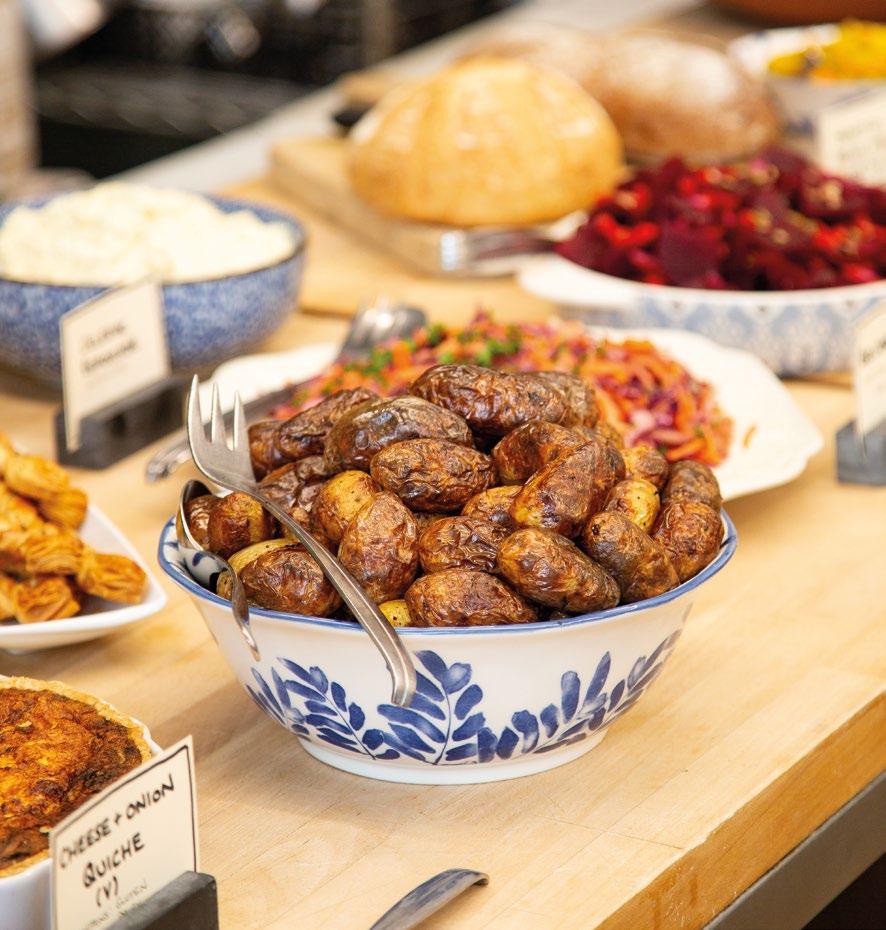
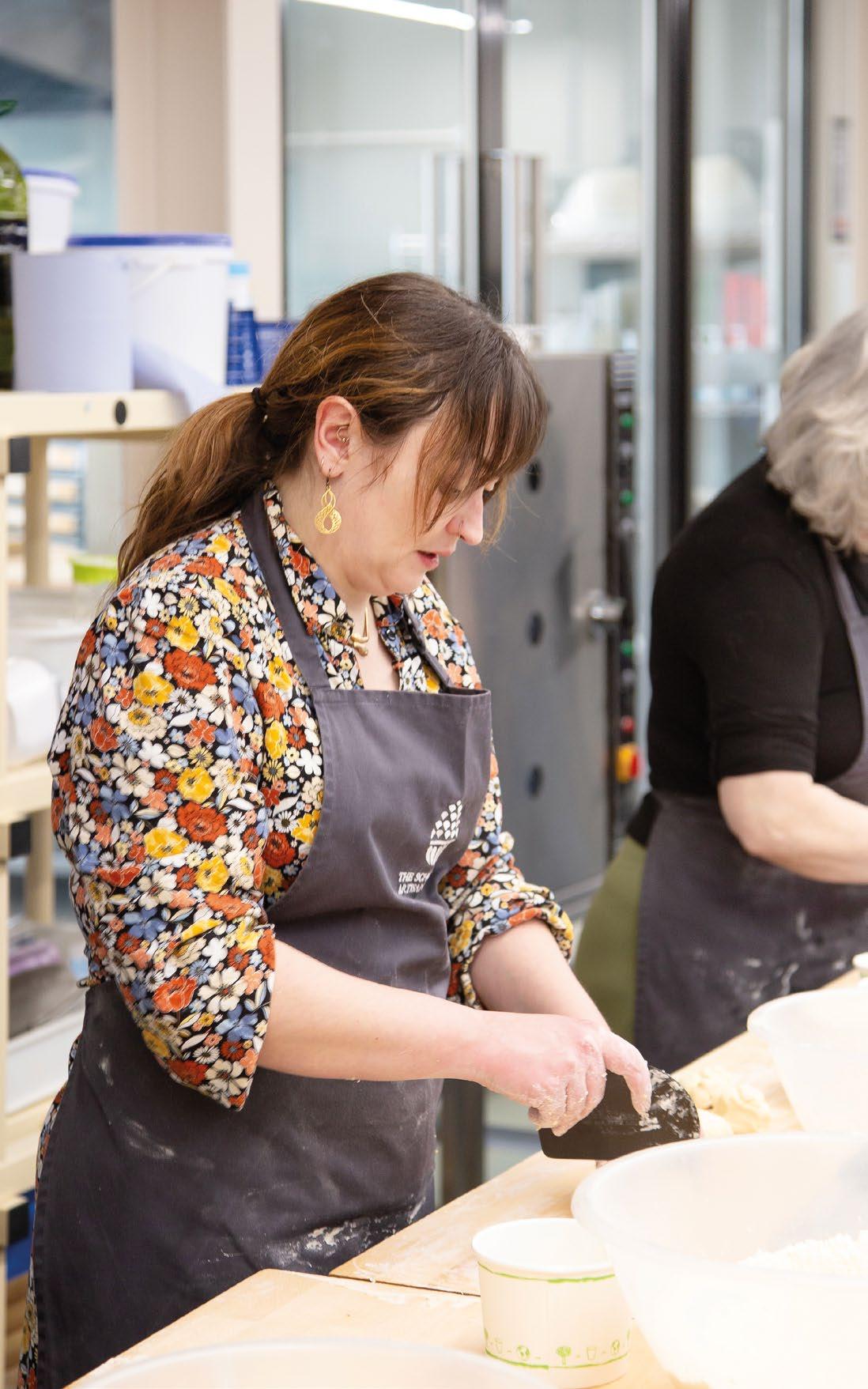
Nestled in the expansive Welbeck Estate in north Nottinghamshire lies the School of Artisan Food, a hands-on cooking school dedicated to traditional processes and proper craftsmanship. Catering to everyone from the hobbyist hoping to perfect their puff pastry to budding professionals seeking the tricks of the trade, it's a haven of all things homemade and an antidote to a food culture dominated by the mass-produced and ultra-processed.
To celebrate their fifteenth anniversary, the School is serving up a special programme of over sixty short courses between June and August, alongside an immersive four-week Summer School. When they invited us to get a taste of what's on offer, it's fair to say we bit their hand off.
We start the day in one of the bright training kitchens with a patisserie class. Stood in our matching School of Artisan Food pinnies at wide, gleaming workspaces, it's giving serious Bake Off vibes. An effect no doubt enhanced by standing opposite Series 9 contestant Karen Wright as we weigh and whisk. I narrowly resist the urge to peer intensely into the oven like my life depends on its contents. It's the closest I, and indeed most of us, will come to the iconic tent.
Luckily there's no panic-inducing technical challenge to contend with as tutor Martha Brown guides us through our first recipe of the day: Chocolate Hazelnut Amaretti Morbidi. Sounds fancy right? They look it too. They turn out to be one of those rare recipes you come to treasure; straightforward to prepare, undeniably impressive. A crisp crackled exterior enveloping a morish, marshmallowy centre. Delicious.
Martha is one of many members of staff who first joined the school as a student, in this case on their Advanced Diploma in Artisan Baking: a six-month qualification for those wishing to work in or establish their own baking business. Martha has done both in the time between studying and returning to share the skills she's honed in the industry.
We move on to the culinary alchemy of honeycomb, transforming sugar and syrup into the centre of a Crunchie bar. Sugarwork can be intimidating to an amateur but Martha's accessible explanation of the process made it simple. Seeing the caramel swell and bubble into a pool of gold as you whisk in bicarb is intensely satisfying.
Next on our whistlestop tour of the school's varied culinary curriculum, Martha talks us through the principles of viennoiserie as she works puff pastry. The process of rolling and folding layers of butter is simple enough but labour-intensive. It gives me a newfound appreciation for the impeccable lamination on the croissants served earlier for breakfast.
There's also a palpable sense of community that runs through the School. Everyone we meet is united in their passion for good food and traditional craftsmanship. The whole Estate is
a sanctuary for small producers - cheese makers, bakers and brewers. More than one mention is made about evening visits to the newly launched rum distillery. 'Idyllic' springs to mind, not for the first time.
Out in the quaint cobbled courtyard, we wander between huge fire bowls to meet Sally-Ann Hunt for an introduction to BBQ. She is a fount of knowledge and her enthusiasm for wild food, fire and smoke is enthralling. Having left behind a twenty-year career in finance to pursue her passion for food and sharing traditional skills that might otherwise be lost to history, she possesses a kind of pioneer woman aura.
It's sensory, it's playful and as the wide smiles on the faces of everyone in the room attest, it's joyous. I've made plenty of bread but I've never had so much fun doing it
She stands amongst the smoke enthusing about the haunch of wild venison hung above the flames, an animal from the Estate's deer park, which she butchered herself. Meanwhile, the shawarma butter-injected cauliflower slow cooking above the opposite ornate fire bowl piqued my interest.
There are audible exclamations of wonder when she opens the door of the cold smoking cabinet. One taste of the smoked cheese is enough to reignite my passion for a long-forgotten project left languishing in my shed: converting a small metal filing cabinet into a smoker.
Our appetites suitably fired up by the delectable smells drifting from the various BBQs and smokers, we take our seats on long wooden benches for a feast in the former fire stable. As I suspected, the cauliflower is a particular delight, as are the homemade quiches and salads served alongside the expertly BBQ’d duck, gammon and venison prepared by Sally-Anne.
Feeling more like a nap than a workshop (or a workout, which we had been fair-warned to expect) we head off to try our hand at baking soft, fluffy focaccia and crip grissini (breadsticks). Kevan Roberts, the gregarious Head of Baking, shares expertise gained from over thirty years in the bread industry; techniques for stretching and shaping, tips for getting children excited about bread baking, tricks for charming your local supermarket
baker into a free supply of fresh yeast... These are things you really can't learn in a recipe book or absorb watching YouTube.
We stand scraping great handfuls of soft, sticky dough into the air before slapping it down and stretching it across the work surface. It's sensory, it's playful and as the wide smiles on the faces of everyone in the room attest, it's joyous. I've made plenty of bread but I've never had so much fun doing it. Cooking as a communal activity isn't something I'm used to. Perhaps now I'll think twice before escorting guests offering help so swiftly out of my kitchen.
Being so starved for time in the real world that many of us barely have enough to scoff down a packaged, ultra-processed sarnie on our lunch breaks. The idea of hand-stretching dough and investing in the hours of fermentation that create great flavour can seem like a luxury few can afford.
We've become detached from the provenance of our food, from the process of creating real food from scratch and from the joy to be found in that process. The school aims to address this. It was founded on an ethos of preserving traditional food skills, promoting alternatives to highly processed food and celebrating good food in the widest sense.
A registered charity, the school seeks to share their knowledge and passion with as wide a group as possible. They fundraise bursaries and subsidies for their courses and work actively with local schools, social enterprises, healthcare professionals and disadvantaged groups to educate on eating well, healthy choices and sustainable food.
Whatever piques your culinary curiosity, chances are they have a course for you amongst the extensive range on offer. The Summer School runs from July 29 - August 23 offering students the chance to become immersed in the world of bread making, patisserie, viennoiserie, pizza making, BBQ and ice-cream making.
Short courses start at £95 for a half-day session and cover a range of skills from bread baking, BBQ and butchery to patisserie, pies and pizzas, foraging and fermenting to curing and cheese-making.
Head to schoolofartisanfood.org to find out more
15 leftlion.co.uk/issue170
words: Claire Jones photo: School of Artisan


A Palestinian in Nottingham
Marhaba! I’m Diala Isid and I’ve been living here in Nottingham for around four years. I moved from Palestine to do my masters at the University of Nottingham and then found a job at a Renewable Energy Company in Beeston called EvoEnergy. I decided to make Nottingham my second home because it felt like one!
It is extremely painful for all Palestinians to see what is happening in Gaza right now. Only those in Gaza can truly know the horrors that are unfolding, but everyone around the world must know that this most recent war did not begin on 7 October. For Palestinians it is the culmination of 75 years of occupation and displacement.
I come from Beit Sahour, a town nestled in the steep hills of Bethlehem. You may know Bethlehem as the birthplace of Jesus, but to me it’s home. It’s where I went to school, where all of my family live and where I eat the most delicious Palestinian food. Bethlehem is in the West Bank, and like any other Palestinian city it has been profoundly affected by Israel’s occupation of Palestinian land. Surrounded and suffocated by a wall built by Israel, with checkpoints and daily military raids all creating a system of separation and oppression.
To run a full marathon in Bethlehem, runners must run the same road four times, running next to the wall and through two refugee camps. The reason for this is due to a lack of freedom of movement that is caused by the West Bank being occupied
Faced with this daily reality, in 2013 together with other Palestinians and with the help of some Danish volunteers, we set out to show people around the world our daily life in the West Bank from a completely different perspective. We founded the Palestine Marathon: a 42.195 KM route that starts and ends at the Nativity Church in Bethlehem. But this is a marathon like no other. To run a full marathon in Bethlehem, runners must run the same road four times, running next to the wall and through two refugee camps. The reason for this is due to a lack of freedom of movement that is caused by the West Bank being occupied by Israel where land is segregated into areas with different juridical control, checkpoints existing between Palestinian cities, illegal Israeli settlements spreading through the west bank and the existence of the wall. The Israeli Occupation restricts and limits where and how much Palestinians can move. So, our marathon aims to highlight this and draw attention to Article 13 of the Universal Declaration of Human Rights, that everyone has the right to freedom of movement within one’s own country.
We started the first ever running group in Bethlehem under the name Right to Movement (RTM) with the slogan ‘We Run to Tell a Different Story’. This was partly to raise awareness and to help to get local people’s support for the marathon, but it was also to give us an opportunity to meet new people and train together for the race. The subsequent growth of our running communities was very organic. I moved to Ramallah, a city to the north of Bethlehem and I started another RTM running community there. After this we grew quickly, making new connections with Palestinian runners throughout historic Palestine and we managed to grow to nine communities during the best times. Right now, there are four active groups in Bethlehem, Ramallah, Haifa and Jerusalem.
Our goals and aims are simple: we are a social running group using sports as a tool to promote the basic human right to freedom of movement that we have lacked for the past 75 years. We are strong advocates for women’s rights and are always ensuring that young Palestinian women can take leadership roles in our communities. But what we’ve come to achieve over the past eleven years is an unexpectedly large network of Palestinians, all sharing the same
words: Diala Isid illustration: Zarina Teli
struggle in their different cities, all eager to be part of a positive community wanting to change the narrative and most importantly all happy to speak up about life under occupation and inspire others to do the same.
One of the RTM communities we had was in Gaza. Our Gazan runners were active for a couple of years and always hoped to meet us and to join our various activities. But the restrictions imposed on Gazans has made it more difficult for the running community to survive. I have never got the chance to meet them because we can not travel freely to Gaza. We require a special permit from Israel to travel between the West Bank and Gaza, something that is impossible to get unless it is for work purposes in a humanitarian NGO. Our Gazan runners have never been given permits to travel to Bethlehem to participate in the marathon or any of the other runs or activities we have put on. The restrictions on Gaza have led many including Human Rights Watch to label it as the world’s largest ‘open-air-prison’.
Being a leader with RTM has given me the opportunity to travel to many countries around the world, to run marathons and to advocate for Palestinians basic rights. The journey for a Palestinian with a Palestinian Passport (West Bank ID) out of the West Bank is difficult and unpleasant. We have to cross both a Palestinian and Israeli border before crossing into Jordan to use the airport there. This means hours of crowded humiliation and frustration spent at the borders, but the majority of the time we manage to make it through. However, for the Palestinians in Gaza, that has never been the case. They are well and truly trapped. Many people will look at what is happening in Gaza and not realise the context of how it has reached this point. They might not know that a huge percentage of Gazans are already refugees from 1948 when the state of Israel was created on Palestinian land. These people were refugees then, have had their houses destroyed in multiple wars since and once again find themselves as refugees again now. They want to return to their villages that now lie in the state of Israel. This is their human right as stated by the UN, but this is something Israel continues to ignore with impunity. The risk of famine in Gaza is now imminent. More than 30,000 have been killed and the world continues to look away.
I gave birth to my first baby during this war on 29 October and I would do anything to protect him. I can not imagine the pain that all the Palestinian women and men have been going through losing their little ones as well as those children whose parents have been killed. I have been finding it extremely traumatising to watch the news and videos on social media of dead bodies. But, unfortunately, it doesn’t seem to bother the politicians enough to make them call for a ceasefire.
Often, I’m asked ‘Do you still have hope for Palestine?’ The honest answer: less so every day. But that doesn’t mean that the weekly marches I see here in Nottingham don’t give me a glimmer of hope. Or Nottingham-based band Do Nothing deciding not to play their South by Southwest shows in solidarity with the Palestinians. Or the multitude of fundraisers put on at bars, clubs, and restaurants across the city. These things give me hope and show me that even though the politicians might not be with us, the people certainly are. Most of all I just want people to see Palestinians as human. To understand and learn about the history of our struggle. If they do that, they can’t fail to be an ally. So please keep talking, keep sharing, keep marching and keep demanding a ceasefire and the immediate humanitarian aid Gaza needs.
If you want to find out more about daily life in Palestine a film featuring Diala and Right to Movement called Freedom to Run is screening at the Nottingham Quaker Friends Meeting House on Saturday 4 May at 7.30pm. Tickets are available through Eventbrite.
17 leftlion.co.uk/issue170
NOTTS SHOTS
Want to have your work featured in Notts Shots?
Send your high-res photos from around the city (including your full name and best web link) to photography@leftlion.co.uk or tag #nottsshots on Instagram.


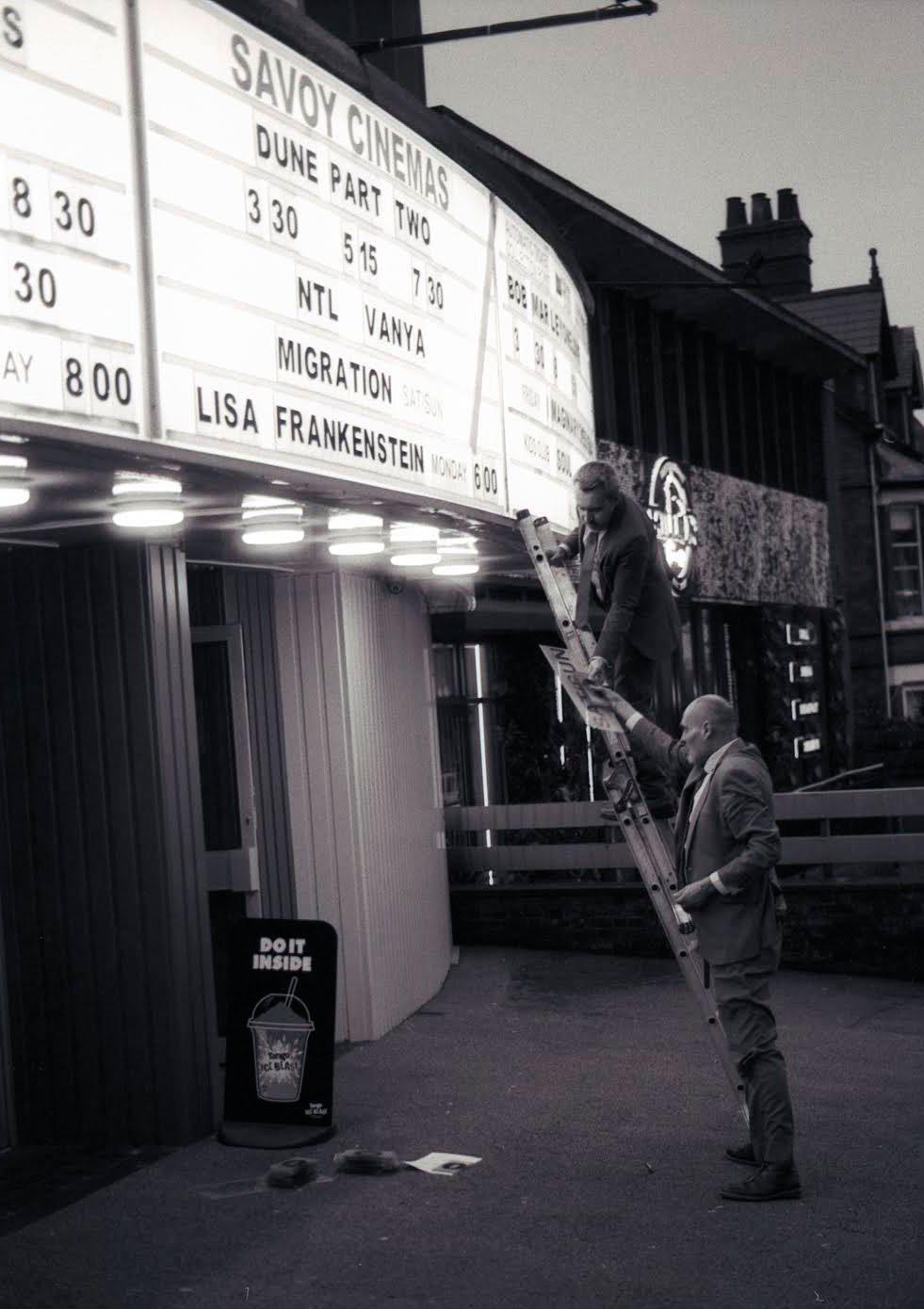
leftlion.co.uk/issue170 18
Art on the Avenues Kinga Gogolewska
Pottering Around in the Night
Sophie Gargett
Cinematic Savoy
George Brumpton

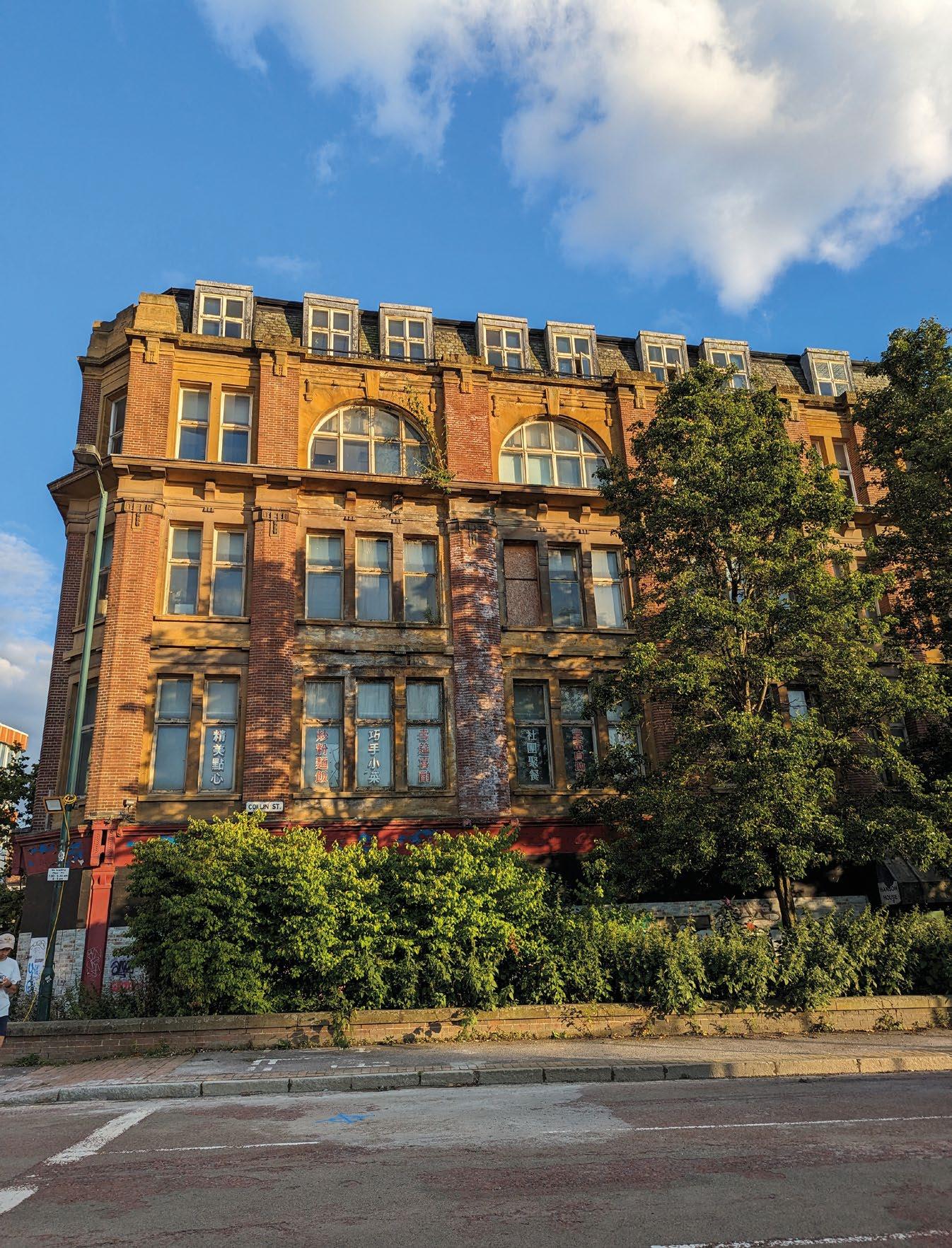
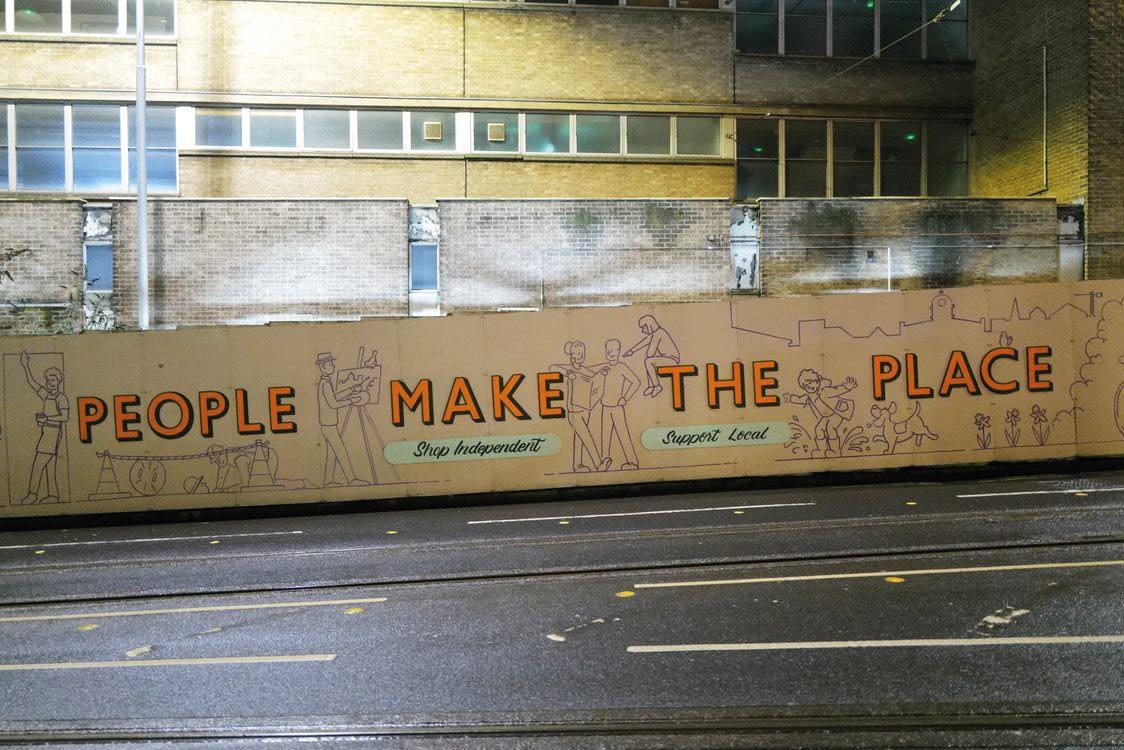

19 leftlion.co.uk/issue170
Looking up at sundown Lindsey Fletcher. @_lindseyfletcher
Stopping Time
Helen Woods
People Make the Place Vikas Sandhu. @everyday.suburbia
Watching the rain fall Peter Taylor


A Celebration of Nottingham Football Fanzines
Two of Nottingham’s best loved football fanzines The Pie (1987-2009) and Brian (1988-1995) are being given a new lease of life thanks to a regeneration project by LeftLion, supported by The National Lottery Heritage Fund.
This event will mark the public launch of the digital archives of both fanzines and include talks, film sceenings, the official launch of the archives and more besides.
7pm, Thursday 23 May 2024
Metronome

leftlion.co.uk/fanzineevent
leftlion.co.uk/issue170 20
interview: Louis Clevett illustration: Toby Anderton
MASTER OF PUPPETS
The Nottingham Puppet Festival takes over the city centre this month once again, and when we saw Rainbow puppeteer Ronnie le Drew was on the line up, we pulled some strings to get a chat with the man who brought Zippy to life…
For anyone too young to remember Rainbow, what was it about and why was it so loved?
Rainbow started way back in 1972 and I think ITV decided that Jim Henson’s Sesame Street, which came over from America in ’69, held too many Americanisms. So, they decided to make their own preschool programme, the Thames version of Sesame Street called Rainbow - little did we know it would air for twenty years.
The premise is, you have father-figure presenter Geoffrey, and three characters, Zippy (a ‘unique’) George (the pink hippo) and Bungle (the bear). We had singers over the years, the most famous being Rod, Jane, and Freddy. They produced three songs a week, which all had different themes. We had funny stories, strong characters, and lots of special guests. Eventually, we had merchandise made with dolls of all the characters. We even won a BAFTA, which was called a Harlequin Award back in those days, we even beat Blue Peter
What creature do you think resembles Zippy the most?
This is interesting because people used to write in and say, “What is a Zippy?” Roy Skelton, one of the original voice-men, said instead of saying he looks like a frog or a certain animal, call him a ‘unique’. We still manage to get away with it even now. Another question we often get asked is, ‘Oh, Zippy we never see your legs!’, so I’d say in Zippy’s voice – “I choose not to show them.” But I have a little mini-Zippy, who I’ll be bringing up to Nottingham. He was originally on a show called Rumplestiltskin and I saved him, he has little legs, so you’ll see Zippy is quite dumpy really.
Puppeteering seems like a real hands-on job, pardon the pun, how did you manage it?
It’s quite the armache holding them up. One hand on the puppet to work the lips and head and the other hand to work his arm. People often complained about why he only had one arm, but we only had two hands!
Do you have any fond memories of special guests like Judi Dench, Beryl Reid, and Pat Coombs?
Oh, they were wonderful. Pat Coombs, known as Patty, played an auntie figure on Rainbow and was so adorable and very happy talking to the puppets. Also yes, Judi
Dench and she’s adorable, absolutely lovely. She was an absolute joy to work with. The biggest guest we had was Ernie Wise, from Morecambe and Wise. Ernie would come in and give comedy advice and to receive it from such a huge star was amazing. I was in awe of all the guests.
We used to go out to student unions, even played Nottingham several times. We’d set out our booth and it turned into Zippy and George’s disco. We’d have a whole set, it was just extraordinary
Back in 1991 on TV Offal with Victor Lewis Smith, a certain Rainbow episode was shown with very adult, satirical themes. What are your memories of this? Well, believe it or not, this was the one episode I wasn't free. I thought Zippy’s operation was a bit different from mine but that’s just me being picky. However, during the years we did do a ‘naughty’ Rainbow, however, you can’t have the puppet’s swearing, but you can have ‘school-boy’ humour, so one started with Zippy going, ‘one-skin, twoskin, three-skin, four-oh’. If kids watched it, they may have thought it was just normal Rainbow, but the wink-wink nudge-nudge to the camera made it cheeky. It’s become an absolute classic and was put on late-night Channel 4. The scripts of this ‘naughty’ Rainbow are found in my book, Zippy and Me
You’re coming to the Theatre Royal in Nottingham this April for the Nottingham Puppet Festival, are you looking forward to it?
Yes, I can’t wait. We used to go out to student unions, even played Nottingham several times, and arrived there around 11pm. We’d set out our booth and it turned into Zippy and George’s disco. We’d have a whole set, it was just extraordinary. We even played Cambridge and Oxford.
About 8 years ago, I got asked to do an appearance for the first time to do a Comic-Con in Stoke-on-Trent, I thought they wouldn’t want to see me there, but I had a friend who
played inside the costume of Jabba the Hutt in the original Star Wars, and he said ‘If you’re going, I’ll go’. It was quite surreal seeing everyone dressed up, even Daleks were going by. There was one guy I remember who passed me and had to do a double take, is that the real Zippy?
I released Zippy and Me in 2019, and I will bring these books with me to my Nottingham show and sell them a little cheaper than they go for in the bookstores. I will be talking about all the jobs I’ve done over the years.
Are any memorable skits or any new projects coming soon?
We did so many funny skits over the years. Zippy and George have appeared in Children in Need in the last two years. Recently, we were singing a song in Abbey Road Studios, along with other famous puppets like, Hacker and Dodge, Mr Blobby, Muffin the Mule, Zelda from Terrahawks, and Captain Scarlet from Thunderbirds
This year, we have a Masterchef episode coming out. We filmed Zippy and George making some chocolate mixture, Basil Brush and Mr Blobby making a mess and we even had one of the Teletubbies come in. I remember one skit I had with Rylan on The Last Leg, back in August 2023, where he was marrying a gimp, so we thought let’s bring Zippy to be his best man, as he had the zips, I popped up and had the rings in my mouth, they loved it.
Was Zippy secretly a ghostwriter on your new book, Zippy and Me? I had two ghostwriters, Duncan Barrett and Nuala Calvi, and it was their idea for me to write a book, I didn’t even think people would want to read my autobiography. We went to a company called Unbound, and they loved it. In about eighteen months the book was published. I was interested in putting in how I got started as a puppeteer, as I feel that’s important for people to hear about my funny old job. Richard Herring even did the forward of the book, which was really nice. If people are keen to find me, they can see a lot of old photos on my Facebook and find a few stories on my website.
Join Ronnie le Drew and Zippy for a talk at Theatre Royal on Tuesday 9 April as part of the Nottingham Puppet Festival
Q @sndodo

 words: Adam Pickering
photo: Natalie Owen
words: Adam Pickering
photo: Natalie Owen
There’s an old saying that a bus is not just a means of transportation, it's a community on wheels. Local bus company trentbarton have been part of our community for over a century now. We put some questions to their Managing Director Tom Morgan about their history, their team and their local environment…
The origins of trentbarton date back to 1913. Can you tell us a bit about its history?
The Trent Bus company was formed on 31 October 1913 and we were in business the following day, taking over the buses and routes of a previous company. One week later, we started our first route between Derby and Stapleford and additional buses were soon being bought. These first new buses were small with around 22 seats, but after a while we bought larger one’s seating 28. However, with the outbreak of the First World War, most of our buses were soon taken by the army for war use.
We continued to develop our services and by 1925 had bus routes radiating from and between both Nottingham and Derby. By 1930 the government had decided that competition in the bus industry was getting too great and passed an Act to regulate it. In 1939 war broke out again, bringing many changes with it, but there was recognition that the bus industry had an important role to play in the war effort.
Fast forward to 1969, we were nationalised and became a subsidiary of the National Bus Company. At the end of 1986 the National Bus Company sold Trent to its local management team and their families, some of these people still own the company today. In 1989 we bought the business of Barton Transport Ltd which had begun back in 1908 and was based at Chilwell.
In 2005 we decided that both Trent and Barton businesses should use the trentbarton name, thus forming the single company as you know it today. Along with this, a new modern colour scheme was adopted, which we could adapt for our different brands allowing us to become locally recognised across the East Midlands. Tickets and paying the driver started to become a thing of the past from 2008 as we pioneered MANGO, our innovative smartcard which is now an appbased QR code.
How many people work for the company these days?
How big an operation is it?
We now have around a thousand team members, from those behind the scenes to the drivers who interact with our customers every day. Every single member of the trentbarton team is working towards a common goal; to ensure that you get really good service. It really is a 24 hours a day operation.
How many bus drivers do you employ? What skills do you look for in them?
Drivers make up around 80% of our team. A good driver is someone with great communication skills and is enthusiastic and friendly with a sense of humour. We look for people who are naturally warm and empathetic towards other people and we train them to drive buses, all done locally at our Langley Mill depot. We’ve found it far easier to find friendly people and train them to drive buses than find people who can drive buses and change their personalities to be friendly.
What are the weirdest things you’ve ever had left as lost property on your buses?
Teeth! I have no idea how you could forget those.
Tell us a bit about you. What were you doing before you started working at trentbarton?
I studied biology and human anatomy at University in Liverpool and graduated not knowing what I wanted to do. I was keen to get some graduate experience in a business and it just so happens that the first opportunity I had was to work for a bus company in Norfolk called Norfolk Green. From here I was approached by trentbarton to join a graduate programme, which I did. I have been in the transport industry, and with trentbarton ever since.
Outside of work I love sports, rugby and cricket especially. I like being active, spending time outside and climbing mountains. I also have a small obsession with coffee. My wife and colleagues make this out to be much worse than it is, but the vast majority of my free time is spent chasing around after my two young kids (a fiveyear-old and one-year-old), hence my regular need for coffee.
How important are environmental issues to trentbarton. Can you tell us a bit about your environmental credentials?
Environmental sustainability is of great importance to us as a business and to me personally (even more so since I’ve had children and I think about the planet we are inheriting leaving behind). “Sustainable” is one of trentbarton’s five values and as such it’s right at the core of our business. Every customer journey done on one of our vehicles, which is replacing that done by car, reduces the impact on the environment. We have an aim in encouraging people to switch one in every 25 car journeys to bus. If this happened we would save two million tonnes of CO2 and there would be one billion fewer car journeys a year.
We’ve found it far easier to find friendly people and train them to drive buses than find people who can drive buses and change their personalities to be friendly
What effect has the recent £2 flat rate bus fare scheme had? Are you seeing more people than ever getting the bus? Is it helping you as a company?
It’s been well received by our customers and because of the scheme we think those customers have been using the bus more. However, it hasn’t achieved modal shift, which is what we wanted to see happen. The short-term additional use from existing customers is great, and our customers appreciate the lower fares, but when asked what they want from their bus services, our customers don’t say they want them to be cheaper. They say they want them to be more punctual, they want them to be more frequent, and they want them to be quicker. It is these priorities I think we should be investing money in; making things better, rather than making things cheaper.
Using the bus should be the best way to travel, it should be the first choice, because it is the most environmentally sustainable and the most efficient. People making the right choice should be prioritised and rewarded. This would also encourage others to do the same. I would reward those people by giving them priority through the traffic jams, and the road network pinch points. I would give them priority access to the city and district centres, making their journeys more convenient, quicker and more reliable.
If we achieved this it would encourage people to use the bus, and reward those already doing so. This is good for the environment, for the economy and for social inclusion. We need brave decision makers to implement the infrastructure to make this change happen.
How has it been getting back to normal after the pandemic? What effect did 2020-2021 have on trentbarton. Do you think things are actually back to normal yet?
I think we’re getting there. There are certainly changes to travel patterns which I think are likely here to stay with more working from home, on certain days of the week especially. Our customer numbers now exceed pre-pandemic numbers which is encouraging for public transport, however our customers who are entitled to




free travel under the National Concessionary scheme are not using the buses in the same way and are still around 20% lower than they were pre-pandemic.
How’s the health of Nottingham’s transport looking at the moment, from your perspective?
We have two of the most successful bus companies in the UK as the two main operators in ourselves and NCT. Between us we have won more UK Bus Operator of the Year awards than any others. The most recent independent survey by Transport Focus highlighted Nottingham and Nottinghamshire were both ranked in the top 5 in the county as having the most satisfied customers (Nottingham 3rd and Nottinghamshire 5th). In the same national survey we were found to have the friendliest bus drivers in the UK (again).
How important is public transport to a local community like ours?

It is essential. If we are genuinely focused on building an inclusive and sustainable future, we have to prioritise those making the right choices. High public transport use is shown to benefit the economy, the environment and aid social mobility. It enables people to access education and training, get to jobs and medical appointments as well as meet friends, socialise and visit some of the amazing venues and attractions we have in the East Midlands.
For people and families in Nottingham can you give them some ideas of really good days out and hidden gems they can get to (perhaps in Leicester and Derby) on your bus routes?
Using our swift route you can get to Uttoxeter Racecourse for one of the best county racecourses in the UK. Using skylink Derby you can get right outside the National Space Centre in Leicester which is a hugely underrated attraction in the East Midlands. Then we have DH Lawrence’s Birthplace Museum on our rainbow one route. If you’ve never been to Tutbury Castle, it’s well worth a visit on the villager route.
For those after some retail therapy, as well as the cities of Derby, Nottingham and Leicester we service East Midlands Designer Outlet, Giltbrook Retail Park and have some amazing market towns with great shops like West Bridgford, Ashbourne, Chesterfield, Bingham and Mansfield.
What’s your own ideal day out in Notts? Got any favourite hang-outs here?
It would have to be with the kids at either Wollaton Hall, with the amazing grounds, lake, café, play park and reindeer or Rushcliffe Country Park. At Rushcliffe there is an amazing sensory garden, ladybird trails, a huge outdoor play area, and Nottingham Heritage Transport Centre next door which has numerous restored heritage buses and a miniature steam railway which can be ridden on in the summer.
What’s the most beautiful and scenic of the trentbarton routes?
We’re blessed in the region with some wonderful countryside and the Peak District on our doorstep. The route which highlights this the most is probably the sixes. The route from Derby heads north to Belper which has a wonderful High Street full of independent shops, before continuing onto Matlock, though Matlock Bath, then onto Bakewell where you can get a traditional Bakewell Tart and some amazing fish and chips. On the way through Matlock you can stop off at the Heights of Abraham and take a cable car up to the top of the gorge with views over the Derwent Valley and Peaks. You can also wander through the spectacular cavern system with a 350 million year old history.
trentbarton.co.uk


23 leftlion.co.uk/issue170
1,000 Team members 250 Buses 14,000,000 Miles covered every year 95,000 Journeys operated 23,000,000 Customers trips in 2023 120,000 Registered mango accounts trentbarton in numbers

Architects of Awe
If you have ever agreed with the phrase ‘there’s nothing new under the sun’, respectfully, you are mistaken. Tucked away in one of Nottingham’s many old lace factories, Architects of Air are once again busy building a wondrous world-class experience like no other. The Luminarium: Luminimax has its international premiere at Lakeside Arts at the end of May, so we went down to the workshop to hear more and see exactly what it takes to build such a strange unique experience.
Part art installation, part sensory experience, this walk-through attraction is really something that needs to be experienced to be understood. Many have compared it to a cathedral, a womb or a cocoon, where natural light is transformed into colourful rays and a sense of awe permeates as visitors explore the space.
Founded in 1992 by Artistic Director Alan Parkinson, Architects of Air is based on the principle of making an accessible, democratic meeting ground that could provide a sense of wonder for people from all walks of life. Popping up in city squares and parks, festivals and universities across the globe, once inside these strange, experimental spaces, the explorer is given a moment away from the busy world to pause, consider and marvel.
“I think the luminarium environment has something special to offer – something that has the capacity to make a meaningful contribution to an individual’s wellbeing,” explains Alan, who started out working on smaller-scale inflatable projects when he was employed by the Nottinghamshire Probation and Aftercare Service during the 1980s.
“The Windbag Inflatable Project was the brainchild of magistrate, Ethel Swann, who sought to provide opportunities for meaningful work for offenders sentenced to serve their punishment in the community by delivering play to inner city children’s projects, schools, and centres for children and adults with special needs,” he explains. The project lasted for ten years in which time it grew to develop more innovative designs culminating in the building of Eggopolis in 1990.
When the Windbag Project ended Alan hit the road with Eggopolis, trying to make a go of selling it to a broader audience beyond Nottinghamshire’s boundaries.
Presenting such a unique concept worldwide came with its own obstacles:
“'Immersive' as an artistic genre did not have the profile it has today,” says Alan, but fast forward thirty years and the luminarium, in its various forms, has been exhibited in more than forty countries, from Sweden to Brazil, attracting millions of visitors. “Word of mouth has been the main route to build awareness. Our marketing is still minimal, we rely on presenters contacting us and we still don't know from one year to the next if we'll manage to break even.”
Clearly, the idea is a hit with crowds, but having had the pleasure of visiting the Teceradix luminarium at Lakeside Arts last year, I was intrigued by how on earth this wonderful thing was imagined, designed and built. Luckily, they are made right here in Nottingham, so I took a trip to the workshop one day to find out.
Each year a different luminarium is brought to life, with new tunnels, shapes and colours created through thousands of pieces of PVC, which are cut and assembled during a period of four to six months. The workshop is a hive of activity with several people working across the room to carefully measure and cut the colourful strips. Large pieces of cut hardboard are stacked up on the walls dictating the shapes needed, reams of lengthy zips are hung awaiting attachment, and in the back, previous luminaria were bundled up and carefully labelled, either waiting to be sent off to a distant country or retired after years of touring. Evidently this is a process that involves much preparation and organisation.
“It used to all be designed by Alan sketching out what he wanted to make, then working it out mathematically using draughtsman skills to create all the curves, but since 2011 Alan’s son Meko has been working digitally using a 3D modelling programme,” explains Jon Gatt, Workshop Supervisor. “Now they work together on design and making templates, then it comes to the workshop, where I draw a floor plan and we work out what goes where.” What I find most impressive is the fact they can’t inflate inside the workshop, so each build has to be exact before being
taken to its location. I’m told even a millimetre of mis-sizing can cause issues. A hope for the best situation, if it wasn’t for the intense precision garnered over decades.
The particular luminarium being built this year is a new concept again - a collection of smaller stand alone ‘luminis’ that can be attached together as a whole, or tour separately for smaller events. “As always, plans can change and more bits can be added to it, so really it’s going to be one of the largest we’ve ever built,” says Jon.
In their modular parts luminis will go on to function as hosting spaces, as part of the new Lumini Project. Overseen by General Manager Izzy Bradley, this gives scope for more people to experience luminaria with a range of different activities inside hosted by community groups. “For this project, it needed to function, as well as being beautiful on the inside,” Izzy tells me. “It needed to have a central dome where everyone can sit to watch something or work together, it needed to have breakout spaces, and a backstage area. So I said to Alan, ‘Here’s what I need, can you make it beautiful?’”
For older people who come in, they say they’ve never seen anything like it - the older you get the harder it is to have a new experience
Bringing it back to the community is still a central tenet of Architects of Air, and making the luminaria accessible and inviting to all is key, from people who use wheelchairs to school children with varied needs. “A big focus for this project is for people with SEN/D, so there will be things like safe spaces if anyone needs it. I’m not sure if we’ve ever worked quite like this before,” Izzy explains. “We want the Lumini experience to be for community groups to get a bit of ownership of the space for a time.”
Another important step in Architects of Air’s future is sustainability. “I'd like to see us refining the aesthetic and the functionality of this art-form,” says Alan. “And I'd like to see us finding a way to do it that uses a material that is more sustainable and environmentally friendly.” While the company donates 1% of annual sales to support environmental organisations, along with reusing as many components as possible, there is currently no infrastructure to recycle PVC plastic used in the build. “We’re constantly looking for organisations or people with ideas for ways to use our scrap PVC or may have a use for our retired sculptures,” Izzy explains. “We’d love to do something innovative with it.”
Who exactly will enjoy a trip to the luminarium I wonder? Of course it is children and families that first spring to mind, but the sense of wonder spans generations. “For children, everyday is new,” explains Jon. “But for older people who come in, they say they’ve never seen anything like it - the older you get the harder it is to have a new experience. We get grandparents coming in and wanting to show their grandchildren what they’ve seen, so it kind of turns it around a bit, and I find that very rewarding.”
Visit the Luminimax at Lakeside Arts Centre, Highfields Park, between Saturday 25 May - Sunday 02 June. Tickets available from Lakesidearts.org
Q @architectsofair_

25 leftlion.co.uk/issue170
words: Sophie Gargett photo: Alan Parkinson
hillsborough words: Peter Hillier illustration: Jim Brown
On April 15 1989, during an FA Cup tie between Nottingham Forest and Liverpool FC 766 people were injured at Hillsborough and a further 97 died as a result of overcrowding in one of the stands. We delve into the depths of the fallout of this tragedy, exploring the hidden trauma and survivor's guilt present within many of the two clubs fanbases.
Trigger warning: Mentions of suicide and violence
A 35-year-old shadow hangs over the lives of a significant number of Nottingham Forest supporters. For some, it is an ever-present; casting doubt, anxiety, guilt or any combination of the three. For some it appears in nightmares, others still in crowds. Gigs, sporting events, boarding holiday flightsanything that really ought to be nice but might just turn out to be the worst thing ever. Grey days. Sunny days. Especially sunny, spring days. For many, the shadow is only an infrequent intrusion, relatively easy to brush off. For a much smaller number, the shadow has been inescapable, other than by taking one's own life. It’s happened. Some never speak of the shadow, even to life-partners, children, best mates. Never. Whatever the impact of the fifteenth of April 1989, anniversaries and matches against Liverpool FC tend to see the shadow looming largest and darkest.
Hillsborough was and remains Liverpool’s tragedy and the legacy on the city is intuitive and well-understood, though not always with due empathy. The 97 who lost their lives as a result of the crush in pens three and four, some of whom could have been saved – unlawfully killed by the actions of the police on the day, negligence of the ambulance service and faults in the stadium design – are rightly mourned and commemorated. A further 766 suffered non-fatal injuries.
Often overlooked, almost 53,000 other people stood helplessly witnessing this unfold, 53,000 survivors. 28,000 of these supporters of Nottingham Forest FC. The majority, on the Spion Kop, initially viewed the tragedy unfolding from the distance of a pitch-length. Some sensed hooliganism and hurled abuse, a product of the times and prevailing culture. As time passed, the true horror came into closer and sharper focus as victims were brought to that end, dying or already dead. From behind the fences, supporters watched the desperate attempts to save lives, the last breaths of the dying and the unfolding trauma of their would-be rescuers.
Some Forest supporters, those at the Leppings Lane end of the South Stand, were closer. Close enough to see the faces, hear the screams and, a particular horror that still haunts many, the smell. Some here tried to help, but recounted being beaten back by the police. Some still relive that experience every time they close their eyes. Personally, I can trace the night
sweats and twisted, grim dreams back to that very date. It’s no coincidence that my dreams start out well and full of promise, but almost inevitably end in some sort of deathly horror. Awake, I dread celebrations and holidays, the fear of impending doom always spoiling the build-up. Sunny, crisp spring mornings may start full of optimistic joy but something darker always kicks in. That shadow.
Others have closer links still. Martin, a home and away Forest supporter for many years, travelled by car to Hillsborough on that fateful day, twelve years old at the time; his Liverpool supporting friend from the same village did not return.
As Steve Hanley wrote in the Brian fanzine, issue 10, May 1989, an issue almost entirely dedicated to reflection on Hillsborough: “I had been excited all week… it was a beautiful day… those present spent 100 minutes staring at the most awful events of our lives”.
Some still relive that experience every time they close their eyes
Still, the tragedy was and remains Liverpool’s. Had the FA and police bowed to pressure to swap the allocated ends, it would have been Nottingham’s. As would the 35 year battle for justice, the false narrative, the abuse and trolling that continues to this day.
Throughout that 35 years, the instinct in Nottingham has been to clam up about Hillsborough. A scroll through posts responding to articles in the mainstream and on social media unveils a hidden epidemic of trauma. Self-inflicted silence. Survivor guilt. A feeling that since that day ‘nothing has been quite right with me’.
Around the time of the Forest-Liverpool FA Cup tie in 2022, BBC Radio Nottingham’s Facebook was flooded with tales of repressed feelings, anxiety and desperation. And also, sadly, some misdirected anger and hatred directed at Liverpudlians, who some still accuse of causing the tragedy themselves. A horrific slur for the likes of J, a sixty year old friend who still lives coping with the mind-bending guilt of failing to be strong enough to hold the crush off his best friend, who died in his
arms. Another nail in the heart of C, whose father was put alive into a body bag and died there, not from the crush but by choking on his own vomit. C faces almost daily abuse online about this.
It was around the time of that cup tie that links began to form. Diane Lynn, a pen three survivor, had already realised that survivors in other parts of the ground would have been affected by what they experienced. Diane and another pen four survivor Peter Scarfe founded and still lead the Hillsborough Survivors Support Alliance (HSA), which offers practical support and specialist therapy for those struggling, frequently suffering PTSD.
Connections made online and in person at memorial events led to the therapy being offered to Forest supporters and, in turn, led to the formation of a Nottingham branch of the HSA. This small but rapidly expanding group offers survivors the chance to talk to others, to share experiences and to develop friendships with people who ‘get it’. The motto, ‘Unity is Strength’, being a lived value, not empty rhetoric.
The Nottingham HSA group is also involved in campaigning and education, particularly against the prevalence of hate chanting; chants which focus on Hillsborough and other tragedies which trigger and cause genuine harm to the families of victims and to survivors. The group was largely responsible, with the financial and practical support of some other high-profile Forest ‘faces’, for the thirty foot banner displayed at Anfield on Forest’s last two visits, calling for respect, solidarity and an end to hate chanting.
Going forward, the group aims to extend the offer of support and, where needed, therapy, to more Forest supporters. It is also hoped to encourage the club, for so long reluctant to recognise the events of that terrible day as part of its own history, to engage and ensure that the much-appreciated and globally applauded gesture of the 97 empty seats at the cup tie can be built upon.
You can learn more about the Hillsborough Survivors Association at hsa-us.co.uk/nottingham-forest-fc
w @ForestHSA
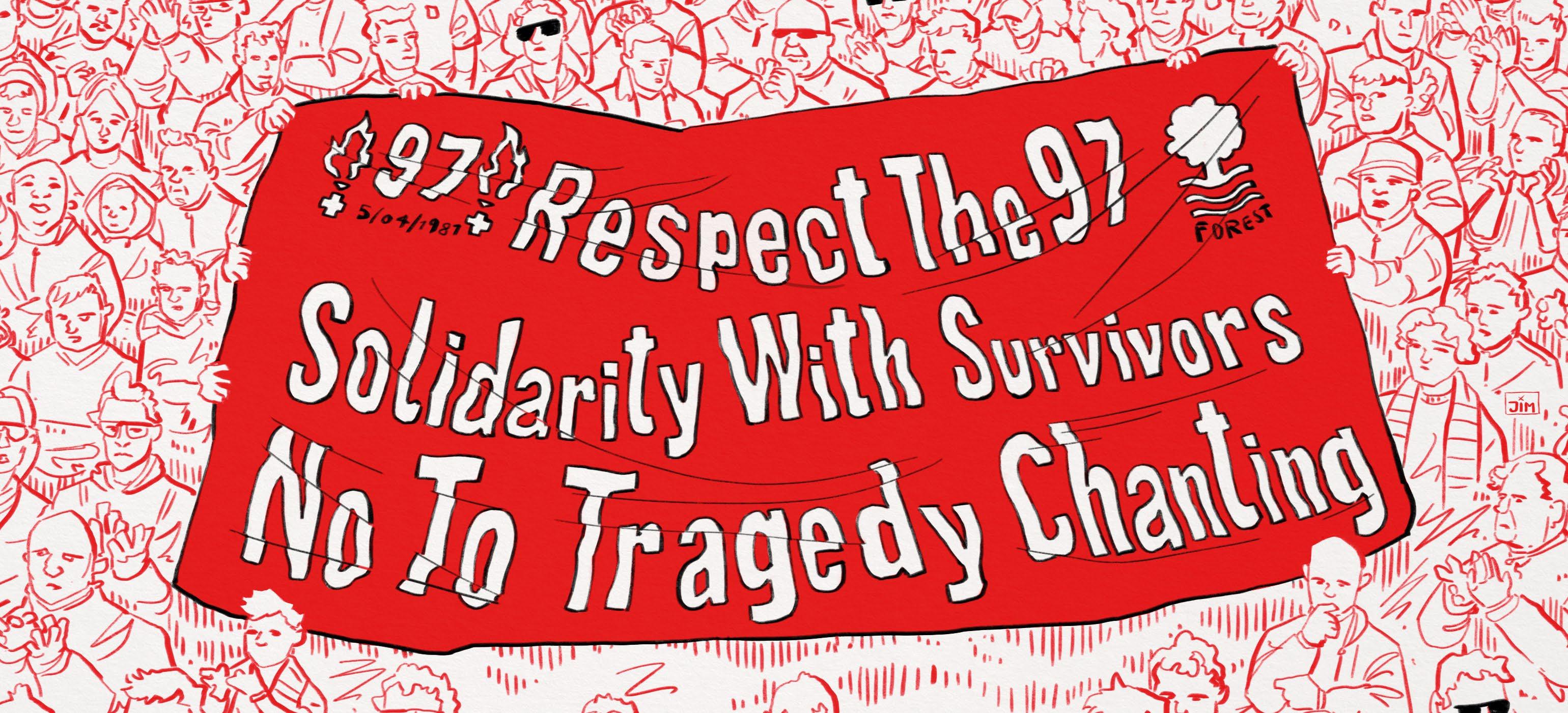
leftlion.co.uk/issue170 26
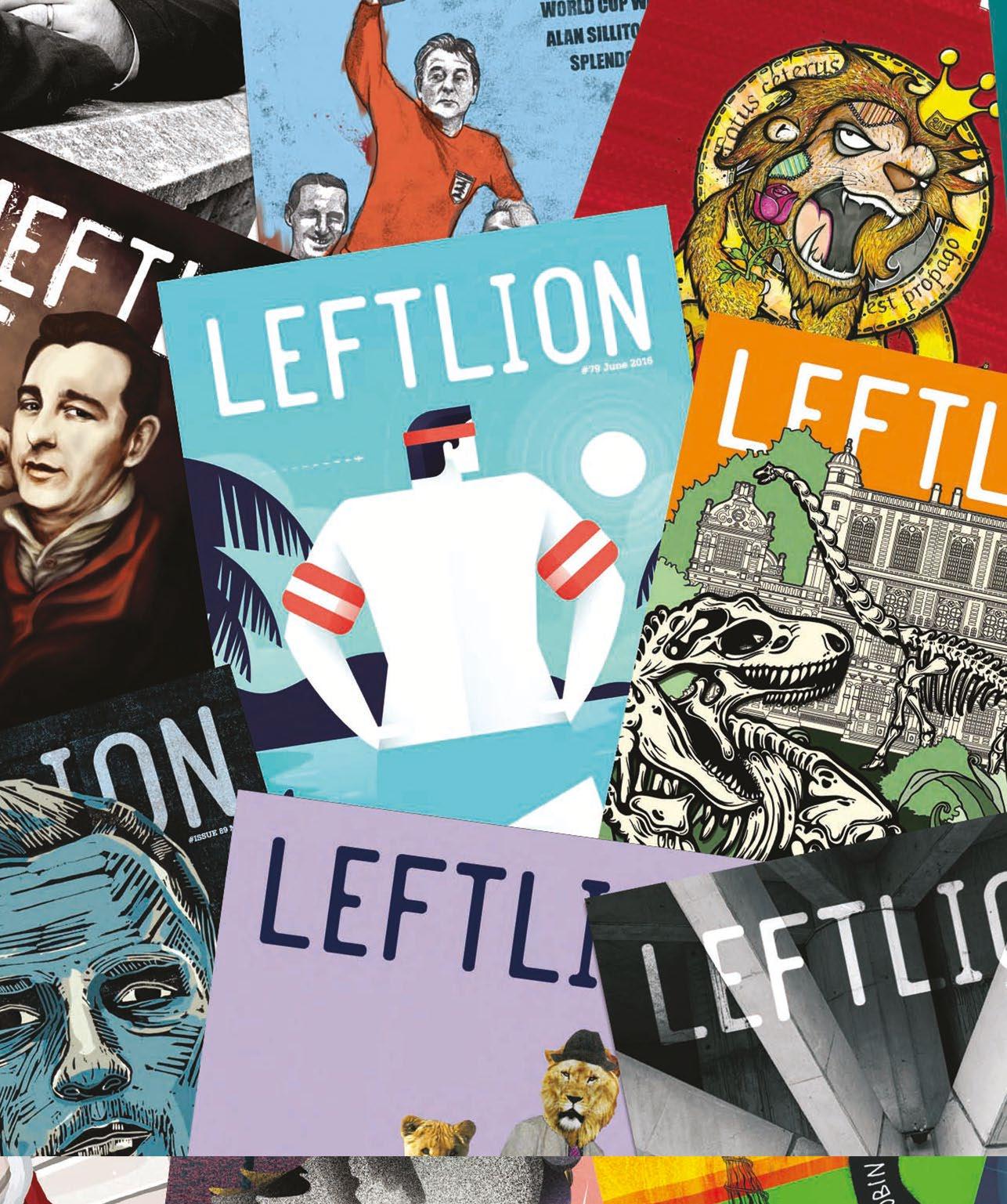
We Might Not Be Here This Time Next Year
As LeftLion enters its 21st year of publishing independent journalism in Nottingham, it’s fair to say that it’s harder financially to keep this all going right now than ever.
You might notice there’s not a lot of free magazines of the quality of this around. There’s a reason for that. The cost of creating, publishing and delivering LeftLion has increased by more than 50% since 2019. Unfortunately advertising revenue, which covers the bulk of the costs for each issue, has also decreased in that time.
Why is this? Nottingham’s once-thriving events and hospitality industry – a core part of our advertising revenue – has come straight out of a pandemic and into a global energy and cost of living crisis. Their costs are rising dramatically, which is why there are currently more empty units around Nottingham than in any time since we’ve existed. Those who still have their lights on have less to spend on marketing.
The cuts at Nottingham City Council are affecting us too. Although we are not directly funded by them –or indeed any other public body in the city – a side effect of the Section 114 notice they have had placed on them is that some of our biggest advertisers are not currently able to advertise with us. This is despite the fact we help them to make more money when they do.
It's a mess, and we don’t mind admitting it’s putting us in a tight spot.
We are increasingly aware that there might be a time when we might not be able to keep printing this magazine each month. So if you’d like to do something to support LeftLion and help make sure that doesn’t happen there are two main things you can do:
1. Become a LeftLion Supporter
It’s a monthly donation of £2-10 via Patreon. You can cancel it at any time and there are various perks involved too. Visit www.patreon.com/leftlion to find out more. Or if you’d prefer to make a one-off donation another way please email support@leftlion.co.uk for details.
2. Tell anyone you know with a business who would like to feature in this magazine about us
Our rates start at less than £100 and unlike most of the corporate-owned media, local people trust us, our readers make us. Email partners@leftlion.co.uk to discuss.
LeftLion gives us a chance to take a breath and reflect on life in Nottingham; shining a light on the positive in our city, lending an ear to the quieter voices and giving you a space to be (sometimes Over)heard. We’ve never been more needed and yet we’ve never been more at risk.
If you love LeftLion #SupportLeftLion
patreon.com/leftlion
Going Rogue
From working at Games Workshop to amassing over 100k followers on YouTube, Louise Sugden is a hardcore Warhammer hobbyist whose miniature goblins have sold into the thousands. We sat down to discuss the art of miniature making, being a YouTube creator, and how the industry is so embedded in Nottingham.
Normally we’d start with asking about you, but let’s talk about the real star. Who’s this goblin then?
Oooooh, that is RH-001 - The Fishing Goblin, the first miniature in my own miniature range called Rascaltown. I drew it as a fun little illustration. Then as a bit of fun, my friend Tom [Wallis], who now works with me, decided to sculpt it and I decided to paint it. We did this as like, “ha ha, wouldn't it be funny if we just made a miniature”. I then decided as a joke, to make packaging assembly instructions and turn it into a product. And then again, as a joke, we decided to sell fifty of them - and it sold out in fifteen minutes, thus birthing my drive to do more and give people more goblins!
When I look at this, I see a cheeky goblin boy. But you're an artist, miniatures painter, designer, YouTuber. What can you see that I might miss? I think it's style. We have some rules in Rascaltown sculpting and it's ‘Give it horns, give it a nose ring and give it little spots’. But people who aren't in the miniature painting scene, kind of just see a toy. What people don't see is that it came to me as a blank canvas. Everything you see painted on it is all my own creative vision. I'm known for a very highly saturated, high contrast, almost cartoony paint job. It looks like a completely different thing when other people paint it. It's one of the reasons I really like miniature painting. You can give a hundred people that miniature and every single one of them will come up with something different.
Your journey started as a hobby before working at Games Workshop for seven years, and then you left to start your business, Rogue Hobbies. That journey is very common around Nottinghamshire.
I have a saying which is that if you throw a stone in Nottingham, you'll hit a Games Workshop employee. A stranger in Nottingham is just a Games Workshop employee you've not met yet.
It’s become a whole industry and given the name ‘The Lead Belt’, from the lead that was once used to make the miniatures…
It's just a term that people use for Nottingham. I used to live in Aberdeen and people would speak about Nottingham like it was a religious pilgrimage for the hobby. You go to Nottingham and there's not just Warhammer World but there's Warlord

and they're all in the same place, so people refer to that as ‘The Lead Belt’.
There’s Mantic games, Warlord games, Wargames Foundry, Perry Miniatures… Curtis Fell from Ramshackle Games works near me. Footsore Miniatures, they work with Curtis I believe. Bad Squiddo - that’s Annie Norman - she's one of the longest running female miniature manufacturers. Alex Huntley from Warp Miniatures, he's incredible. He's just done a gnome Kickstarter. It's a hell of an industry. I think a lot of people don't understand how good it is for Nottingham to have this industry.
But it's not a Games Workshop phenomenon. There’s some combination of this place, this hobby, and these people, not all ex-Games Workshop, that makes something I struggle to describe. It’s a special kind of creativity. How would you describe it?
It's passion. It's hard to describe why miniature painting is so attractive. To me, it's meditative, it tickles my little crow brain of collecting shiny things, it's a community, it’s creative. It's just great and people love it so much. Whatever you're into, there is a miniature and a community waiting for you and it's quite friendly and nice.
Part of that passion for Games Workshop was reaching a point where you felt, ‘Now is my time. I'm leaving.’ A lot of people know that feeling. For all that's involved, that is a creative decision, as much as putting a frog on a fishing rod on a goblin. What was that like for you?
It's so hard. It felt like I was ripping myself away from a timeline where I was happy and settled and I was in the best place for me. It's almost like you're mourning for that future that could have been, that you wanted. And that's what it felt like, for me. It wasn't like there were hundreds of people going, "Oh, if Louise had their own channel, I’d definitely watch it.”
Doing YouTube was something I never planned for until I had to. It's not something you can say is gonna go well. There's no secure guaranteed income at all - that's terrifying. Then making goblins was something I never planned. And now I’m accidentally a miniature manufacturer as well. It's insane. We've sold over a thousand goblins, which is crazy, considering we only have two. It's mind blowing.
If you could go back to that earlier Louise and give her advice, what would it be?
It's almost redundant because I didn't listen to anyone else that said it, but that it was okay. I think the thing that I told myself at the time is that just because you're leaving Games Workshop doesn't mean that your love for Warhammer lessens. But now you get to do it on your own terms. Now you get to do it more. Now you get to have more fun.
What’s that thing you're saying is okay?
It's really hard to point to. As long as you work hard you can make a living for yourself. But on top of that, have some fun. Do a stupid video. People will still enjoy it. Maybe people want to hear my opinion on a space marine. I’m not very self confident, so that has been a struggle. That maybe [it’s okay] people aren't watching the channel because I'm a Games Workshop ex-employee but they're watching it because I'm Louise, the hobbyist, and that's good. I'm of value. Not just my contribution, but maybe, maybe, me.
Louise’s miniatures are available at roguehobbies.com
M @roguehobbies

interview: Richard Minkley photo: Louise Sugden


Funneh Talk
The Nottingham accent is an intrinsic part of our local identity, but what exactly makes it unique? Is it set to disappear with new generations? And what are the effects of sitting right in the middle of the North-South divide? We put these questions to Natalie Braber, a professor of Linguistics at Nottingham Trent University to get to the bottom of it…
Since studying English language at A-level I’ve always had an interest in language and especially in the cultures surrounding it and the variations in the way we speak. This interest was reignited recently when I saw a clip on Notts TV discussing local dialect with Natalie Braber, a Professor of Linguistics at Nottingham Trent University.
I have always been a proud Mancunian but the Notts TV clip resonated with me very much when Natalie talked of language being a really important part of our identity. It was this that made me wonder how much language makes us who we are, and encouraged me to learn more about the Nottinghamshire dialect in particular. Eager to learn what makes Nottinghamshire dialect as equally unique as the rest of the accents and dialects that have emerged from Britain, I booked myself in for a chat with Natalie to see what more she could tell me.
The first thing I was intrigued to talk to Natalie about was whether or not she thought language is becoming more homogenous in today’s society, with impacts like the vast amounts of TV, media, and social media we are exposed to in our day to day lives.
Natalie introduced me to the linguistic term ‘dialect levelling’, which is the theory that eventually there could be an eventual reduction in dialect varieties, but she shortly reassured me that was not her own personal opinion.
Thankfully, Natalie reaffirmed that although language is certainly changing and spreading more easily through the mediums of TV and social media, between cities there’s still a massive amount of variation as accents are staying strong and are a big part of who we are.
Following on from this discussion I wanted to know what made Nottinghamshire dialect unique and asked Natalie how to distinguish and identify language in the Midlands. It turns out being a Midlander is more complicated than you’d think - as Natalie found out during her research: “I did a study with 320 seventeen and eighteen year olds. I gave them a blank map and said ‘if there is a North and South divide then draw a line on the map’. My next question was ‘are you a Northerner or Southerner’, but I didn’t mention [the word] Midlander as I wanted to see what they would
say, and most of them either didn’t answer it or said that they weren’t sure. People in Derby were a bit more likely to say Midland, people in Nottingham were more likely to say North, and people in Leicester were more likely to say South, but overall they were not quite sure”. Natalie believes that due to cultural underrepresentation of the Midlands through outlets like film and tv, people associate themselves less with the Midlands and more with their specific city. “I don’t think many people say I’m a Midlander or an East Midlander, they say I’m from Nottingham,” she explained.
Nottinghamshire words like ‘cob’ and ‘mardy’ are definitely staying and won’t be going out of fashion anytime soon, but lots of local dialect words are disappearing
Intrigued about the impact of the North and South divide, Natalie went on to tell me about a research project at the University of Sheffield that concluded the divide to run directly in-between Nottingham and Leicester, and signified how this geographical dynamic has impacted Nottinghamshire dialect. Caught up in the middle, Natalie explained that the Nottinghamshire dialect contains sounds from the North through pronunciations like ‘bath’ rather than ‘barth’, and also various sounds from the South. After discovering this, it became evident to me that having a variation of regional influence is part of what makes Nottinghamshire dialect so unique and so embracing of their city.
Another interesting perspective Natalie pointed out within this topic was the lack of acknowledgement towards the East and West divide in Britain, which reinforces the cultural differentiation in the Midlands and injects pride of embracing your roots. For example, although to those who are not from the Midlands would see little variation between the East and West, Natalie told me that “people here in Nottingham would be very quick to say ‘I’m not from Birmingham, or I’m not from the West Midlands’ because there is a significant variation in their dialect.”
Thinking about the change in dialect over time, I asked Natalie if there were any Nottinghamshire dialectal phrases that are disappearing, and whether there is a generational difference in usage of such dialect. Natalie reaffirmed to me that infamous Nottinghamshire words like ‘cob’ and ‘mardy’ are definitely staying and won’t be going out of fashion anytime soon, but also told me that lots of local dialect words are disappearing.
Natalie explained this deduction through another recent study of hers: “I chose twenty dialect words (with words like ‘croggy’ and ‘corsy’) and had a group of over sixty year olds and a group of sixteen year olds and I flashed up the cards to see how many they knew. The older speakers knew them but the younger ones had never heard of them. There was however a girl from Mansfield who was only about six or seven and she knew all the words and it turned out she lived with her grandparents who were local and spoke that dialect.”
This study insightfully reveals not only how local dialect can be sieved out of our lexicon, but also how new words and phrases are created replacing the old through generational change, it also reveals the significant impact of our surroundings on the way we speak and the words we use. This highlights that language is something that is always changing as we rediscover and discover new words throughout our lives. Natalie’s work also helped me realise that language is such a big part of who we are and how we define ourselves, leading me to the conclusion that language will never be homogenous because each city or region's dialect is so individualistic and unique - and that’s how we like it!
Natalie has done so much fantastic work on this subject and it was fascinating to get deep into the research around linguistics. One of the most valuable and memorable things she left me with was that as humans we want to belong to a group - we have lots of ways of doing that and language is a key part. This highlighted to me that a lot of life is about feeling like you belong, and one of the most amazing ways to feel that is to embrace your community, have pride in where you’re from, and what you sound like.
words: Alfie Beswick
illustration: Kathryn Cooper
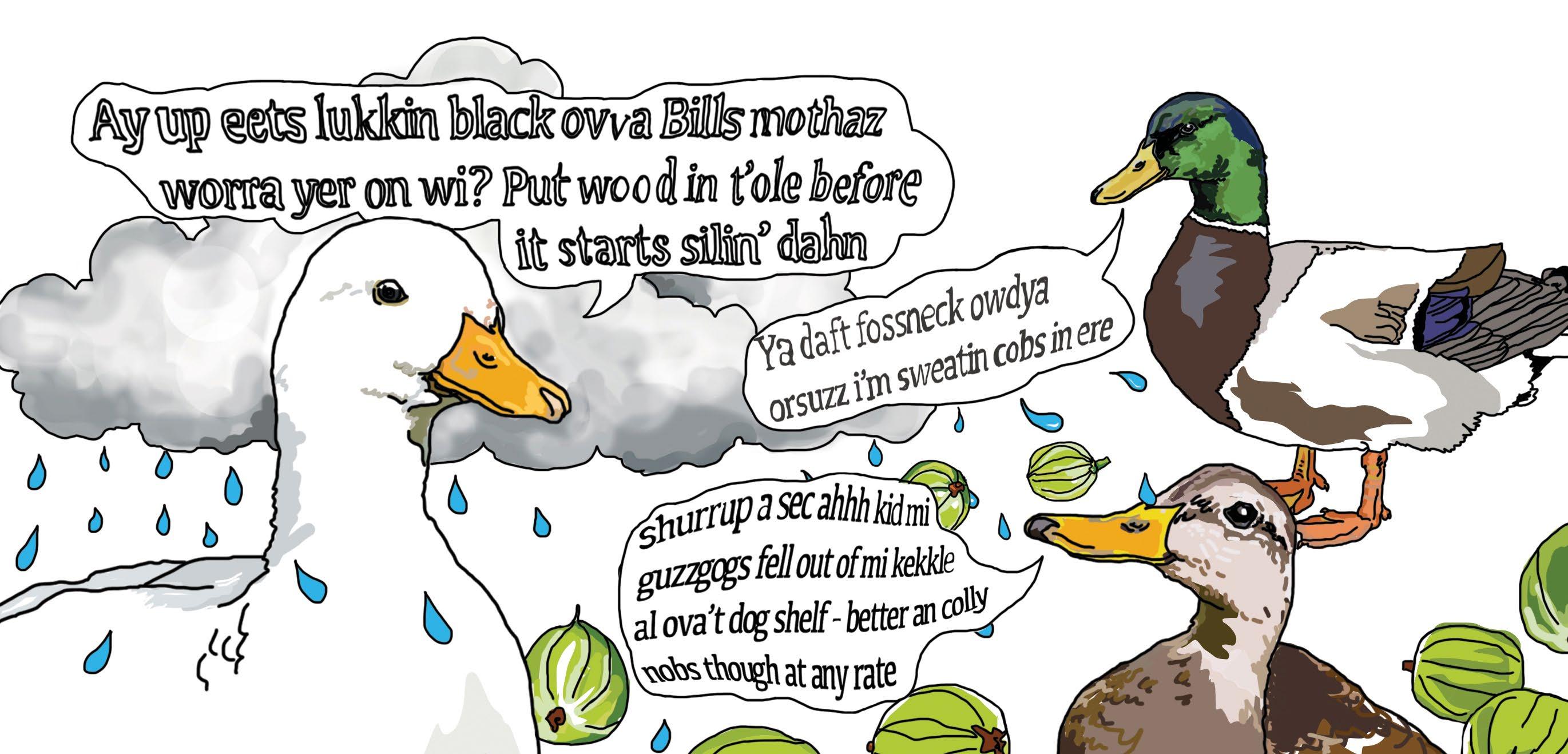

Made in tHis toWn
words: Oliver Parker
Bywater

Like many Nottingham born actors, Eve Austin came up through the esteemed Television Workshop: Nottingham’s very own drama school aimed at helping people of all ages develop their acting skills. She’s currently starring in six-part BBC series This Town and we caught up to hear about how she got into acting and the importance of opportunities for young working class people.
Eve started acting at the age of eleven, and as she auditioned for her place at Television Workshop, she also auditioned for a role in a Shane Meadows commercial, which would go on to be her first official acting role. However, despite the longevity of her career, Eve doesn’t remember a deep passion for acting as a child, or any specific performances that spurred her to consider a similar artistic path; she does, however, say her mum tells her she was “always very keen on being famous.”
Due to not being a family with much tradition in watching films or television, Eve mentioned she used to spend her time mostly hanging out with the boys ‘pretending to be a cadet’ – which we both agreed is definitely acting to some degree, and maybe subliminally led her down the path she’s on now. A path which has led to her acting in long running TV shows such as The Athena, feature films such as Our Ladies and also a role in the theatre, starring in Sophie Ellerby’s LIT. When discussing the differences between acting for the screen and for the stage, Eve mentioned that in theatre you have more control over your own acting and “you can feel immediately, what the audience are wanting particularly with comedy, whether they're receptive to it,” allowing for a unique style of acting from the screen.
Her new show This Town is a six-part miniseries for the BBC, about a group of young people navigating life in the West Midlands during the 1980s, specifically in the burgeoning scene of punk and ska music. The entirety of the show is written by Stephen Knight (Eastern Promises) who has used many of his personal experiences growing up as inspiration for the series and directed by Nottingham director Paul Whittington (White House Farm). The show looks at how this group of young people used music as an outlet to get through particularly hard times both economically –most come from different kinds of poverty – and socially, as they go through some of the toughest stages of growing up.
Eve plays Jeannie, a central character who inspires the show’s main character Dante to begin making music: something that remains key to the entire show. To all the characters music is a form of escapism and Eve used her own upbringing, which was surrounded by her mum’s love of Reggae, as inspiration for her character. For Eve a big part of the process was learning about the rich cultural history of Ska and getting to learn the deeper cuts within the genre; she even talked about how the cast “made a Spotify playlist all together”, which aided long days on set.
This Town undeniably feels influenced by the youthful energy found in Shane Meadows’ This is England and for Eve, the entirety of Nottingham has certainly shaped her acting career, taking inspiration from fellow television workshop actors such as Samantha Morton (Movern Callar) and Vicky McClure (Line of Duty). Eve tells me that to her they were important because “they came from similar backgrounds, similar lives,” and felt like they represented something away from the more affluent drama schools which often leaves the acting world underrepresented in more working-class communities.
You put that opportunity in any city, anywhere in the world, you would find very, very talented young people
She continues to talk about how their dedication to championing Nottingham is so important for younger people from the city to understand they too can actually make a career out of acting, especially given how precarious the industry can be, and how much things can fluctuate within it. Of course on the back of this, we briefly spoke about the unavoidable looming danger of cuts and budget restrictions, alongside the damaging impact on not only Nottingham’s cultural scene, but the entire of the UK. Whilst Eve was at the Television Workshop it had already had its funding cut, relying on private investment from ITV.
She spoke about how brilliant an opportunity the workshop was for working class people in Nottingham. “You put that opportunity in any city, anywhere in the world, you would find very, very talented young people” …A statement that is slowly becoming less common in the precarious world of arts funding. Fortunately it wasn’t all doom and gloom when it comes to film and TV production in the Midlands as Stephen Knight is opening up a new studio in Digbeth, Birmingham for new directors to use, helping to get more creative talent flowing into the area. We spoke how this is a great step in helping the film industries slow progression out of being completely dominated by London centricity and allow more opportunities for young people in Nottingham.
This Town is out now on BBC iPlayer.
s C reen 33
Q @evexaustin
photo: Stewart
FarM-to-Fork Fare
interview: Julia Head photo: Timmy_Fooduk

From the chaotic scenes portrayed in series like The Bear to the high tensions captured in British dramas like Boiling Point, the intense atmosphere of restaurant kitchens is no secret. These environments are often characterised by extreme stress, with high-end establishments notoriously earning reputations for mistreating staff and inhabiting a sub-culture of abuse and exhaustion - so bad that it’s described by some chefs as akin to ‘going to war’.
However, Jericho, a fine-dining restaurant that is quite literally off the beaten track on a farm deep in the Vale of Belvoir, is challenging the status quo. Owned by self-taught couple Rich and Grace Stevens, their restaurant offers a sanctuary from the industry’s norms on their family land and provides an encounter with sustainable and ethical farm-to-fork dining cooked over fire. We sat down with Rich to get to the crux of it all and learn more about how Jericho is reshaping these perceptions of kitchen culture.
Let’s start by going back to the roots and where it all began: in this modernrustic barn which has been converted into a beautiful restaurant now known as Jericho. Why did you open Jericho? And what inspired the concept?
Jericho represents over two hundred years of farming our land. It’s a testament to the generations of our family who worked hard to build and maintain a life here in the Vale of Belvoir. When the current Duchess of Rutland took our land away, we were faced with a difficult decision: either sell the farmstead and move or stay and diversify. Our stubborn farming blood made us choose the latter and our hospitality business was born.
All our inspiration and ethos come from a deep connection to the place we call home. Farming values underpin our style of hospitality, which is a warm and honest welcome, with the best ingredients sourced directly from the people who grow, rear, and farm them. It’s real food from real people.
I’ve been lucky enough to dine at Jericho a few times now. It’s always been interesting to have a view of the open-plan kitchen and watch you and the other chefs working together. Can you tell us more about your kitchen culture?
I would say that we are rooted in our location and legacy, but our culture is progressive, adaptive, and self-aware. It’s a culture based around friends cooking and serving together. At first glance this looks idealistic, but it’s a perfect framework and we are proving that with every service. Moreover, our customers comment on our calm and collected kitchen regularly.
So, tell us, how does your ethos set you apart from others in the industry? It might sound simple but it’s quite complex and meaningful and takes constant work. Grace and I put huge emphasis on trust, accountability, and responsibility, but above all we need to be enjoying what we are doing. Through enjoyment we can cook great food; we are creative and innovative, and we work as an all-equal team. Our communication is calm and effective, and we always support each other. Mistakes happen, but rather than offer negative criticism we work out why and learn from them. A culture like this can only exist when egos are put aside, and purpose is at the forefront of what we do. We have a constant narrative on how we can improve and support proactive self-awareness. A restless desire to improve is ultimately what drives us forward.
It may not be as extreme Ralph Fiennes’ role in The Menu but restaurants, particularly high-end restaurants, are notorious for having toxic workplace environments. How is Jericho changing those perceptions? As a self-taught cook, I haven’t worked in such places and so can’t comment through experience, but in my opinion toxic kitchens are outdated and offer nothing to our industry. I pity them and just like on the playground, bullying never leads to anything positive. We believe that ego-led kitchens stifle creativity and progression, ultimately leaving no room for personal development. They also harm the hospitality industry by discouraging potential talent that could one day be the avant-garde. Jericho is a collective entity and is not reliant on one person’s fragile ego. There is no room for toxicity here. We encourage curiosity, creativity, and confidence. We embrace passion and feed appetites for learning. To cook with
your heart, you need to feel valued and secure. We all feel like we are a part of Jericho and love it in our own way.
I agree. It seems there is a discourse that one’s ability to endure suffering in the kitchen is measured against character and worth. How do you personally develop the chefs working for you? Is there a strong sense of hierarchy?
I think to be measured like this is a consequence of insecure leadership. Hard work is a commitment, but it is only productive when it’s enjoyed, not endured. My hope is that kitchens that make people suffer won’t exist in the near future, which would lead to our country’s food culture benefiting substantially. Our kitchen is also not hierarchical and has never been. We all feel the food and energy together and work towards one common goal which is to keep getting better. I trust my team to develop themselves through experimentation and observation. We learn from each other, from books, and from our experiences.
Ego-led kitchens stifle creativity and progression, ultimately leaving no room for personal development
It’s commendable what you’re doing, and certainly gives other restaurateurs some food for thought. What is next for Jericho? Any big plans for the warmer months ahead that you’d like to share?
Just like any farm, our restaurant is intrinsically linked with the outdoors. One of its first incarnations was outdoor seating only. As summer approaches, we are looking at how we can use our beautiful outdoor space and communal fire pit as an inclusive part of our dining experience. Excitingly, we have also purchased two large teepees from Gareth and Amelia at Ynyshir in Wales and will be offering accommodation - if and when it stops raining!
Obviously, you’re based in the Vale of Belvoir, which is a little bit of a drive out for some of our city-dwelling readers. In one hundred words or fewer, can you tell us why it’s worth the trip?
Where we are is what makes us so individual, and it’s what drives us and grounds us. The truest explanation of what we do is that we bring our guests to the ingredients, and we give them an experience of what’s around us. Because of our ethos, if we were anywhere else, we would be completely different. You can’t have one without the other. We are defined by our location. I would add that our experience is one of the most honest you will find in the area and it’s not that far. The trip is worth it.
Find Jericho at Orchard Farm, Plungar, NG13 0JA. Bookings can be made through their website
Q @restaurantjericho
leftlion.co.uk/issue170 34
F ood 34
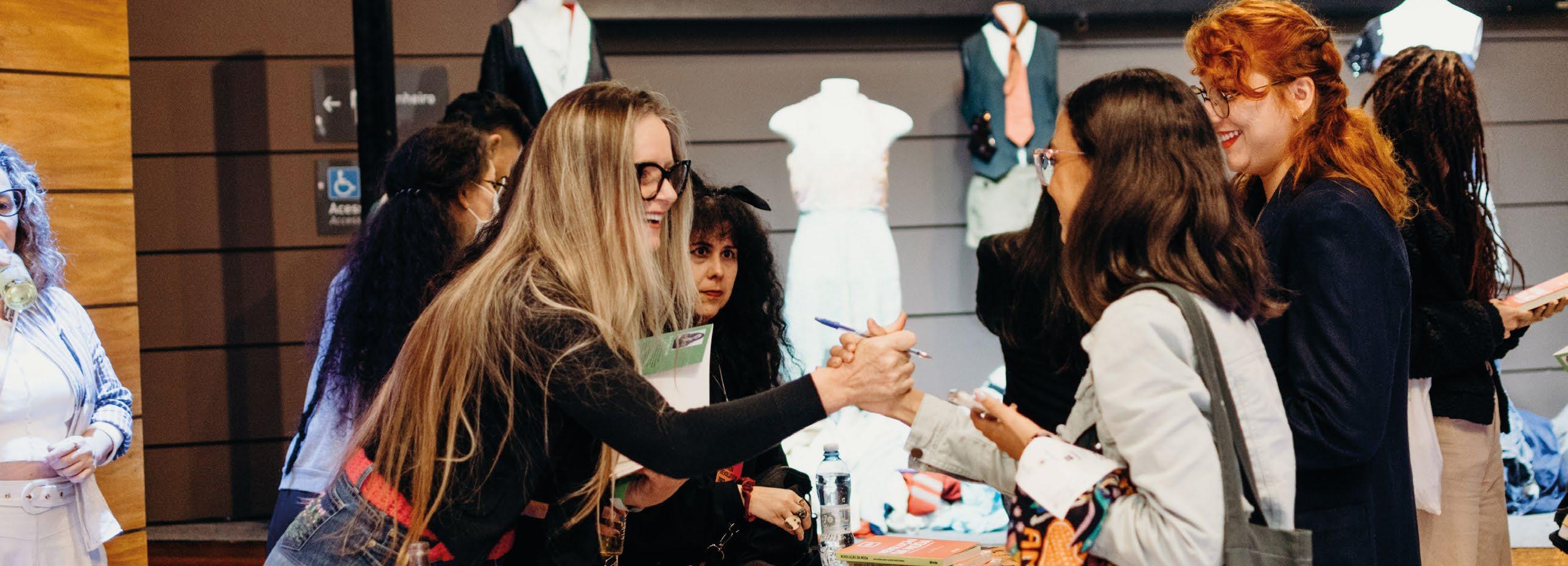
Fashion Revolution
words: Addie Kenogbon photo: Fashion Revolution
In celebration of the 10th annual Fashion Revolution Week, a national campaign of fashion activism which takes place this year from 15 - 24 April, we delve into how Notts locals can do their bit to support the cause right here in our city.
Fashion Revolution Week is the world's largest fashion activism movement, and each year seeks to rebel against the disposable mindset of the current global fashion industry, while addressing issues such as human and environmental exploitation; transparency and accountability across the supply chain as well as the current ‘throwaway culture’.
It was launched by the founders of global movement Fashion Revolution, Carry Somers and Orsola de Castro, and each year takes place around the anniversary of the 2013 Rana Plaza disaster. Widely considered to be the fourth largest industrial disaster in history, the event saw 1,134 people killed, and more than 2,500 others injured after the collapse of a garment factory in Bangladesh where clothing from many of the biggest global fashion brands were manufactured.
In the ten years since the disaster, the fashion industry is still riddled with fast fashion brands who exploit workers and manipulate buyers with practices such as greenwashing, which uses deceptive marketing to persuade shoppers into believing that their products are environmentally friendly. Or, the likes of SHEIN, Boohoo and Pretty Little Thing selling goods for as little as £1 or even 10p during Black Friday sales, which only serves to escalate the throwaway culture that is leading to tonnes of garments ending up in landfill and polluting our environment.
However, there are some brands and cities who are being the change they want to see and Notts is certainly one of them.
Nottingham is a city which has had an undeniable impact on the fashion and textiles world. A city where style and sustainability have been woven into the very fibre of its being, long before sustainable fashion as a movement was even a thing.

Re-Fashioned Revolution: The Charity Fashion Show at Metronome
Tuesday 16 April at 7pm | £3.50
Featuring a range of looks styled by NTU students using clothing donated by Oxfam, guests can shop the runway outfits after the show. All proceeds go to Oxfam.
Some might say Nottingham’s sustainable fashion journey began with its lace making roots, which saw lace makers source quality cotton for their iconic lace patterns ensuring their garments stood the test of time, eventually getting handed down through the generations.
More recent years have seen other Notts brands championing sustainability, including the likes of fashion house Paul Smith, which a few years ago committed to using more materials with a lower environmental impact through its Sun Logo collection.
Notts consistently tops the charts as the top location for charity shops, vintage preloved finds and thrifted treasures, boasting almost 200 charity and vintage shops across the city
All Paul Smith garments that sport the Sun Logo contain at least 50% low-impact materials such as GOTS certified organic fibres, organically grown cotton, recycled fibres, responsibly sourced woodbased fibres, natural rubber, leather from LWG rated suppliers or materials such as vegetable or bio-based fibres. The brand’s SS23 collection achieved a level of 78% low-impact materials, with a view towards achieving 100% in the coming years.
Meanwhile, businesses like family run Notts business Ettos, are helping to revolutionise transparency in the fashion industry with its digital platform that empowers clothing brands around the world to gain complete transparency of their supply chains. Allowing brands to foster sustainability,

Mend in Public Day
Saturday 20 April
Grab some friends and your needle and thread then get out into your local community and stitch in protest against disposable fashion.
accountability and traceability, Ettos marks an integral step towards a more transparent and ethical fashion industry, where brands and manufacturers can verify the sustainability of their entire supply chain.
There are other ways the city’s fashion industry is doing its bit to help too, in fact Notts consistently tops the charts as the top location for charity shops, vintage preloved finds and thrifted treasures, boasting almost 200 charity and vintage shops across the city. This includes the likes of charity shop giants White Rose which have a range of shops across the city centre as well as Beeston and West Bridgford, and further afield in places such as Sheffield, Leicester, Derby and Newark. Or, popular vintage shop COW which recently launched its kilo thrift store last year.
While it’s encouraging to see so many positive steps in the right direction when it comes to revolutionising the current fashion world, there’s still a way to go with the most recent figures stating that fast fashion accounts for 1.8 billion tonnes of carbon emissions each year, 35% of microplastics in the ocean and 20% of global freshwater pollution. In addition, according to Fashion Revolution’s Fashion Transparency Index 99% of the world’s big fashion firms are still underreporting on the numbers of workers in their supply chain who are paid a living wage.
That’s why movements such as Fashion Revolution Week are still as important today as they were ten years ago. And, in a world that continues to be ravaged and pillaged of its goods for a cheap look or where people’s lives come second to the latest trends it’s never been more important to help bring about further change. Thankfully, there are so many ways you can get involved.
@fash_rev

Opt for preloved or shops with transparent sustainability credentials. We recommend: COW and COW Thrift, White Rose, Lucy & Yak, Hopkinsons, Garms, Relic x Hooked, Karma Vintage, Happy Sunday, Argang Store, Karma Vintage, Rebekah Peters, Ford & Guy Visit do sHop
35 leftlion.co.uk/issue170 F as H ion 35
H ook & eye
Housing deterent
words: Benjamin Weare photo: Dani Bacon


While access to housing should be an undeniable human right for all, in 2024 buying a home is sadly beyond the realm of reason for many. For those left looking to rent, behind the scenes the process of finding a place comes with an increasing amount of red tape and bureaucracy…
Late last year I was fresh out of my graduate degree and in need of a new place to live. I was keen to ditch my old Beeston flat, an echoey white box with very little natural light, in favour of something more cosy. I had never moved house while unemployed or during a housing crisis, but I was sure in a week or so I would be set up in a new place. It was closer to two months.
The first hurdle was that there didn’t seem to be many flats available, although plenty of rooms in shared houses. I found this true wherever I looked, with hints that it was not localised to Nottingham. This was highlighted when chatting to a landlord who remarked that it was a bad time for renting due to a low volume of ‘rental stock’ being available. His phrasing stuck out to me, as though living space arrived on pallets in the back of a truck. I guess it’s true in a coarse sense, shown by the new-builds near my Beeston flat that took deliveries of brick and timber from lorries to synthesise new living spaces. I’m not familiar with the specific alchemy by which raw materials are transmuted into homes, though I did notice by a quirk of the process at least two of the newly transfigured dwellings were already being advertised as rentals. I didn’t discover if these were build-to-rent properties, or if they were quickly snapped up by a landlord, and in any case I wasn’t able to arrange a viewing before they were let-agreed.
My biggest frustration as a prospective tenant was even getting to view flats. Adverts were left up after the property was gone, and usually if I didn’t call the estate agent on the day it was listed I was wasting my time. Most calls to estate agents would last less than a minute, consisting of a flat declaration that the property was already taken. Individually, not so bad, but en masse they started to wear down my resolve. I suspect many tenants are familiar with this particular attrition. The call that sticks out in my mind was when instead of hanging up I asked why flats went so quickly? They kindly informed me that in this case, the prospective tenant had arranged a viewing in-person at the estate agents offices before the online ad went up. Being first to view the property, they had rapidly turned around a successful application. I’m not sure how I’m supposed to compete with that, without finding the time to regularly tour the estate agents of Nottingham.
My turning point was mid-August, when I went from unemployed to salaried. I had been looking at jobs in other cities and had not been looking forward to engaging with the rental market in York or Ellesmere Port, so it was a relief to stay in Nottingham. I applied for a nice place during this week, then was rebuffed by the landlord as my contract had not yet come through. The estate agent offered me a compromise – was I willing to pay twelve months rent in advance? I didn’t pursue the flat. Perhaps yearly rent payments of several thousand pounds are common and I simply haven’t come across them, but it was remarked to me that I should have asked if the landlord pays their mortgage in yearly instalments. To me it felt like employment, as it affects tenancy application, is a binary. Until the moment a contract is signed I was liable as a risk, while afterwards I became a trustworthy tenant.
Employment meant I was suddenly successful in tenancy applications. Perhaps the perception of guaranteed income soothed the minds of landlords. The next hurdle was that different estate agents ask for similar but different information
during application, making it more frustrating to do several at once. For example I didn’t mind disclosing my salary (of which I had not been paid a penny), but some agents want net monthly salary and some want gross yearly salary. There’s also guarantors, which mitigate risk when taking on a tenant earning less than an arbitrary threshold. As a friend remarked, it’s a shame that this income threshold keeps lagging behind wages for people starting their careers. They will also often ask for three years housing history; I was fortunate to not have had a turbulent recent past, as there was no space in the process to explain the presence of lots of short tenancies that might be off-putting. In general I found that applications tended to flirt with being invasive, with high requirements for having a guaranteed income and stable living situation stacking the application against the tenant. From conversations this seems to be a national theme, not localised to Nottinghamshire.
Perhaps yearly rent payments of several thousand pounds are common and I simply haven’t come across them, but it was remarked to me that I should have asked if the landlord pays their mortgage in yearly instalments
After a successful application comes referencing. Many of the details required overlap, the dividing line depending on the estate agent. I expect many struggle to get this far, scuppered by lack of affordable properties and intense competition. In my case, referencing was handled by a deft chatbot. On the scale of cute to weird I rate this chatbot rather well, with occasional glitches that may have been bad luck. The big gremlin squatting on my keyboard was that the chatbot needed a phone number to contact my old landlord. He didn’t provide voice references so would not give me a number. That was entirely fair, but I couldn’t find a way to explain this to the bot. It just kept politely asking me for a number with a trusting smile on its digital face. In the end I had to give it a dud number, and the referencing service proceeded to contact my landlord via email anyway.
Eventually I was lucky enough to rent a flat in Nottingham. Abandoning my house search is a relief; my experience was of lost time and wasted emotional effort, full of small inconveniences that are each a grain of grit in the eye. I have no idea how I would have found the time to do this if I had been actively working, or raising a family, or suffered from disabilities. I was never at risk of homelessness, and I can’t imagine the suffering of having it hang over your head while attempting to navigate rental bureaucracy. The whole process felt actively hostile to unemployed people or those with a history of unstable housing, both across the UK and beyond. The difficulty I had in finding a flat made me feel like I was fighting invisibly against other renters, all competing for the luxury of a place to live.
leftlion.co.uk/issue170 36
C o MM unity 36
sWap sHop
words: Rachel Jackson
illustration: Lily Keogh
The Sherwood Exchange is soon to reopen, taking lessons from Lockdown on sharing time, skills, and resources amongst the local community. Now, in 2024, as we battle the cost of living and concerns about the environmental impact of household waste, we hear from founder Rachel Jackson about the revival of the exchange…
It seems a life-time away since we were concerned about empty supermarket shelves and how our neighbours were getting by. Yet just four years ago, we were preparing to go into a lockdown and starting to worry about going without our favourite foods and everyday household items. Still, on March 30, 2020, I was opening the Sherwood Food Exchange: Sherwood's answer to ensuring we redistributed some of that pasta and toilet roll and anything else going spare. We came together as a community, and it was brilliant.
It all started after I'd taken my first trip out to the shops after six weeks with my leg in plaster. I remember the giddy excitement of that first trip out and the excitement of being able to leave the house, only to be followed by genuine shock and disappointment at not being able to find anything but a few onions to bring back with me. Then, whilst driving home with the fruitless results of my below-par shop, I started to wonder whether there could be another way. Some system where everybody could get their food and groceries without having to go without.
The exchange brought people together through sharing and a sense of kindness and giving last time—sentiments definitely needed within these challenging times
That night I began to plan a safe outdoor food exchange. The exchange, which was then called the Sherwood Food Exchange, was kindly housed, and funded by Mike Douglas from the Sherwood Business Centre, and staffed by a team of volunteers who visited throughout the day to clean it down, rotate stock, and refill it. In its infancy, the Sherwood Exchange consisted of four outdoor food containers where people could bring surplus tinned and pantry goods, such as fruit and vegetables, confectionery, household goods, and toiletries. The exchange was well used, and although it was open at specified hours, it was accessed at all times of the day and used considerably by almost all who found it.
Fast-forward three years, and I found myself worrying again. Wondering how we could all come together as a community to support each other during worrying times. Seeing the devastating impact the rising costs of living were having on all members of the community, and experiencing struggles myself to afford the same standard of living I had afforded three years ago. On top of this, concern over our impact on the planet became unavoidable, I even attempted to stop watching the news to preserve my mental health. Everything was becoming stressful, and I knew I had to do something; I thought, if it wasn't me, who might it be instead.
It was clear that the exchange would need to be restarted. The exchange brought people together through sharing and a sense of kindness and giving last time— sentiments definitely needed within these challenging times. And so, the story goes, I put the word out and started to plan towards opening last year. This time, with the aid of committee members and volunteers who came on board to help us get to where we are now. We have also been fortunate enough to secure an indoor venue, The Place Activity Centre in Sherwood.
This vibrant local community centre faced closure last year, but is now on its way to
becoming an exciting and varied venue, featuring an art exhibition and community garden, alongside offering a multitude of varied classes and a recycling point in the Sherwood Exchange. Thanks to them, the exchange is now housed in a permanent base where all the donations, such as food, can be free from weather damage. The exchange has also been blessed with brilliant volunteers. Volunteers who have undertaken training to offer advice to visitors who might need that little bit more support, such as signposting to local agencies advising on health and wellbeing, finances, and housing.
The exchange will also become a place where people can share and learn new skills. Plans are afoot for volunteers to deliver mindfulness sessions and other beneficial classes in the future. Our volunteer, Cal Phoenix, a local eco and biodiversity gardener who runs the Apollo Phoenix, is developing a green space within the centre's car park. Cal's plans are to attract wildlife and grow fruit and vegetables to be available at the exchange, alongside hosting an exchange of unwanted gardening utensils.
"Due to rising costs of living, people don't have the money to be able to garden. However, through setting up my community interest company, Apollo Phoenix, in conjunction with volunteering at the Sherwood Exchange, I am trying to change this," says Cal, "I am here to enable everybody to garden. Whether that's an entire garden or a windowsill. I'm here to educate, inspire and empower people to have access to the things they should rightfully have. I'm also here for nature and wish to share skills amongst the community on how to increase nature and biodiversity within their gardens, no matter how big or small they might be."
Volunteers and visitors can also join a time bank. The time bank—run by Time Banking UK—is a scheme where people donate their time and skills for other people to access. This can range from mending or fixing items to baking a cake. The Time Bank will provide a fantastic opportunity for people to share skills and resources across the community.
The Sherwood Exchange will open officially on Saturday April 6 and will be open every Saturday from 12–4 pm. You may visit the exchange to donate surplus items and swap them for other goods. You can visit if you don't have anything to donate. You can even bring other items to recycle, such as old mobile phones or printer ink and cartridges. A trip to the exchange is strongly advised before visiting the shops to ensure money is saved and less food and resources are wasted.
The Place Activity Centre will be having an opening day on Saturday, April 20th, where visitors can visit the exchange, listen to live acoustic music and poetry, or even try out free classes such as eco and biodiversity-friendly gardening, which will be taking place outside the centre that day. For more information about this event, please email theplace@thplaceactivitycentre.org.uk or phone 07487877536
Come and visit The Sherwood Exchange for yourself at the Place Activity Centre, 2a Melrose Street in Sherwood from 12-4pm on Saturdays from 6 April 2024.
Q @sherwoodexchange
E sherwoodfoodx
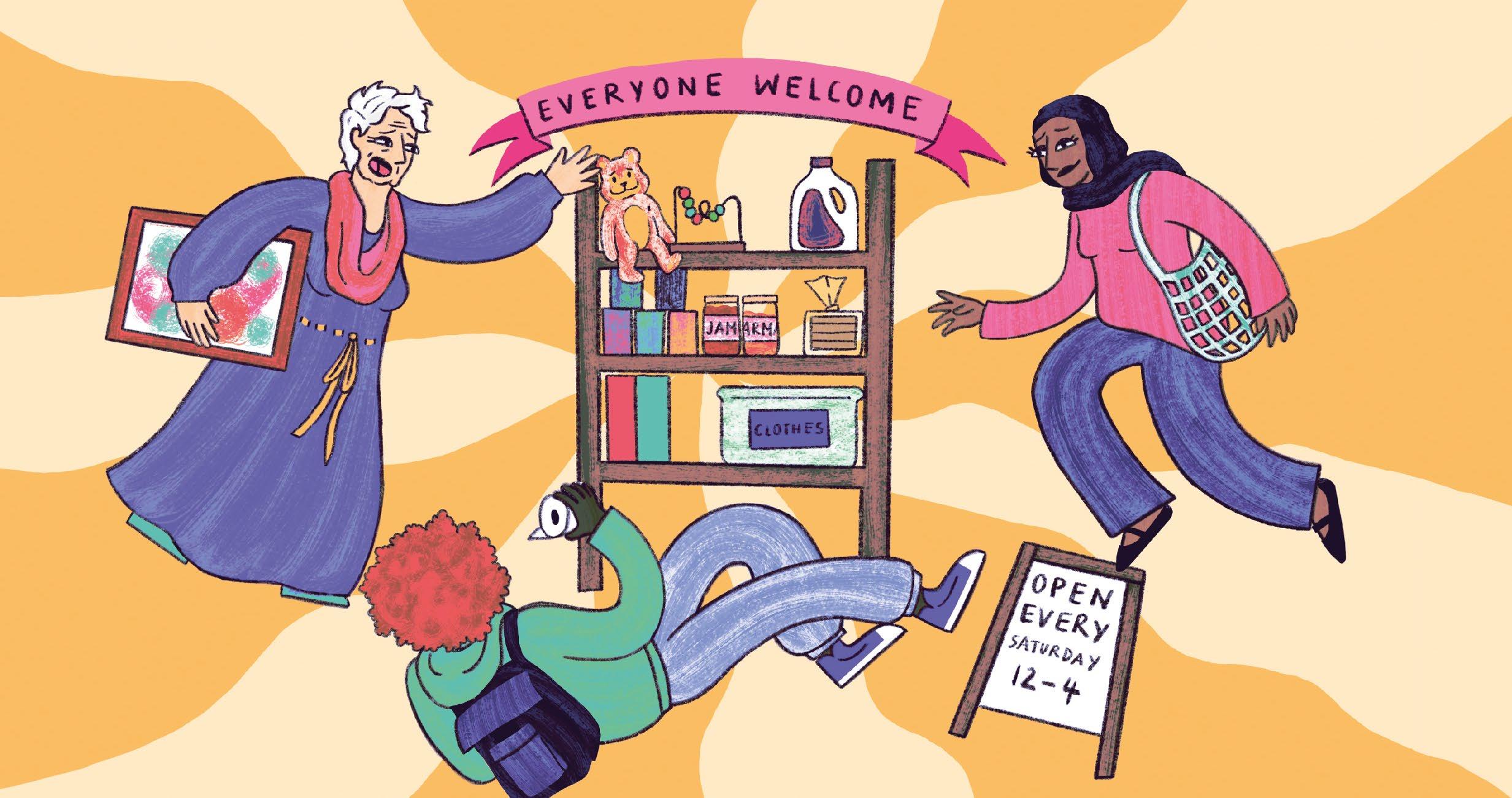
37 leftlion.co.uk/issue170
en V iron M ent 37
underground art

Nottingham is a unique city, the home to many famous historical figures, it’s a place brimming with culture and history. One feature however, sets it apart more than any other; its caves. Archaeologist Cameron Black went to Fascinating Finds from Nottingham’s Caves, the new exhibition at Nottingham University Museum to see what has been unearthed of Nottingham’s ancient history.
I’ve been lucky enough to go down a few caves myself, and as part of my job I've been involved in archaeological work recording one in the city centre, so when I heard about the new exhibition, Fascinating Finds from Nottingham’s Caves, I was really interested to see what had been found in them over the years.
For those who don't know, none of the ‘caves’ are actually natural. The Sherwood Sandstone upon which Nottingham sits is easy to excavate, and over the years residents have taken advantage of this, digging a sprawling labyrinth of tunnels and caves beneath the city streets. Nottingham actually has more man-made caves than anywhere else in Britain, over 800 are already mapped, and there's likely plenty left to find, even in 2023 several lost ’caves’ were discovered.
The earliest reference to the caves comes from the tumultuous 9th century, in the Welsh monk Asser’s Life of King Alfred (893 AD): “the above-named army of heathen … advanced to Nottingham, which is called in Welsh Tigguocobauc [Place of Caves], but in Latin ‘The House of Caves’” [Speluncarum Domus]
A fitting name for a place where it was common to find people living underground until around 1845, when the St. Mary's Inclosure Act banned the ‘renting of cellars and caves as homes for the poor’ (though this didn't immediately end the practice).
These remarkable structures have seen continuous use for over a thousand years, forming a key aspect of Nottingham's identity. Some boast elaborate carvings, pillars and staircases, whilst others are modest and practical. The hand-carved spaces have been used as everything from homes and pubs, to air-raid shelters and prisons, evolving with the city to suit its needs.
They were and always have been spaces for work and spaces of leisure. Nottingham’s caves are a unique part of the city’s archaeological heritage and we should definitely celebrate them
The exhibition uses themes of ‘work’ and ‘play’ to highlight ways caves were used, it features an impressive range of objects from different periods of history, all found in the caves of Nottingham.
Visitors can see these objects first hand, some of which are on public display for the first time. They range from fancy fragments of 17th century serpent-goblets imported directly from Venice (at a time when the production of clear glass was difficult and expensive, these would have been luxurious items indeed), to more modest everyday things, such as a bone comb and some clay tobacco pipes. My favourite was the chamber pot (portable toilet for use at night) ‘prominently featuring’ the image of Charles the Second (son of the deposed and beheaded Charles the First).
I spoke to Dr Christopher King, one of the exhibitions curators:
Why did you decide to put this exhibition together?
There are thousands of objects which have been excavated from Nottingham’s caves by many different individuals and groups over the decades, and they are kept in lots of different places – we have a large collection at the University of Nottingham Museum, other material is held by the City Museums, the National Justice Museum, and community archaeology groups. We wanted to put on an exhibition to bring together all these disparate finds and tell a story of Nottingham through time.
Which objects do you personally find the most interesting?
I think the mediaeval alembic is an absolutely fascinating object. It is really rare to find a complete example – they are normally in fragments. This was used to distil spirits, or extract oils – it could have been used in the home, but perhaps it was also in the workshop of an apothecary, making medicinal remedies from herbs and spices.
What are your thoughts on the King Charles chamber pot?
It’s such an interesting object. This was found in a rock-cut well underneath the site of the Castle Inn, which was one of the most prestigious inns in the city, right next to the Shire Hall. Was it a royalist object, showing loyalty to the newly restored monarchy? Or is the fact that the King’s head is on a chamber pot a bit of 17thcentury satire?!
What should people know about the caves of Nottingham? And what would you like them to take away from the exhibition?
The caves contain a huge variety of archaeological finds and I hope our exhibition shows just how much information they can tell us about life in the past – they were and always have been spaces for work and spaces of leisure. Nottingham’s caves are a unique part of the city’s archaeological heritage and we should definitely celebrate them.
I recommend anyone interested to visit, and explore the artefacts on display. Every object has a history, and I believe that when you see an object from the past, you catch a glimpse of the world it came from.
The exhibition is in the Nottingham University Museum at Lakeside Arts, open Thursday to Sunday 12-4pm, until Sunday 7 July.
Q @lakesidearts
38
38
art
words: Cameron Black photo: Nottingham University Museum
Kai-Otee About It All (Single)
Fan of Lilac Grove? Well, you may have also heard of the new duo on the block, Kai-Otee, since guitarist Ryan is a member of both! We’ve covered Lilac Grove aplenty in the past, so this time we’re focused on Kai-Otee and their latest single About It All. With plays on BBC Introducing East Midlands and BBC Radio Nottingham, it’s clear to see why. This is a slice of rock that anyone can enjoy, with energetic riffs and hard-hitting drums - the two elements that the project serves as an outlet for, according to the duo, and two things we are very much enjoying here at LeftLion. Gemma Cockrell

Di$mal Pure Water (Single)

Roshan Sabet Melody for Tiamat (EP)
Immersive and chaotic, Melody for Tiamat truly embodies the ancient sea deity it’s named for. Each track is built around two or three repeating phrases of Sabet’s iridescent guitar, which are meticulously layered to submerge the listener in ethereal, ocean-deep music. Loops flow in and out like the tide, their disparate rhythms overlapping so that the layers feel less like melodies than clashing weather fronts. We are under the ocean, in a rainstorm, but Sabet’s minimalist, masterful guitar always finds us, guiding us to tranquillity among the chaos. An intriguing EP that offers more with each listen. Sam Marshall
Nottingham based Hip-hop artist Di$mal has just released his new single Pure Water, providing the chill, wavy vibes for the start of 2024. It is definitely one to lift your spirits and its melodic hook and catchy beat will definitely give you a much-needed boost in this rainy start to the year. The local artist started his career in 2021, with NeverMinD which ended up making it onto BBC Radio Nottingham, and we hope to see more of the local alternative rapper in the coming year. Louis Dargavel Corbett
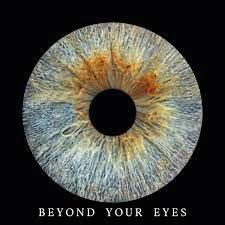
Rat Face Lewey
Falling For Love Again (Single)
Sharon Watkins
Beyond Your Eyes (Single)

Who knew someone with such a beautiful voice, and such critical acclaim, lived down the road in West Bridgford? Well, those of you who are already lucky enough to have discovered Sharon Watkins knew… but those of you who don’t know of her yet, then today is your lucky day. Beyond Your Eyes, her latest single, tells the tale of falling for someone who struggles to express their feelings, starting with a string quartet introduction before seamlessly transitioning into a pop-rock song that is guaranteed to tug at your heartstrings. Gemma Cockrell
This established band have been doing their thing since 2013 and are now readying the release of their third full-length album, The Last Days of Lewey. Born of the isolation spawned by the pandemic, the record is a concept album that follows the fate of a heroic character named Rat Face Lewey, and its lead single Falling For Love Again is an introspective, uptempo, lo-fi, indie-rock meditation on the fleeting nature of love and the different meanings that it breeds. Their first release since 2019, it definitely sparks excitement about what’s to come from this three-piece in the near future. Gemma Cockrell

Drone Queen
CARNIVORE (Single)
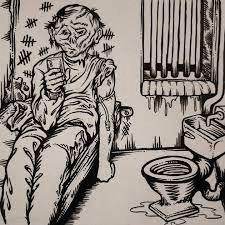
Following the release of the eerie Intro, Drone Queen has now released the single CARNIVORE. While the first release served to build anticipation, it feels like this is truly our first taste of what the Drone Queen project (a pseudonym for Nottingham born singer and songwriter Lewis Hill) will offer. This rock tune is raw and hardhitting. The sound allows the meaning behind the emotionally poignant lyrics to flow naturally throughout the track, as they are cathartically released through the music. Gemma Cockrell
If you’re from Nottingham and want to get added to our list of music writers, or get your tunes reviewed, hit us up at music@ leftlion.co.uk
39
Musi C r e V ie W s

express oFFiCe portiC o
Ahead of their EP launch gig at the Old Cold Store on 11 April, we chat to the funky, synth-pop, seventies-infused band Express Office Portico all about Incommunicado, support from BBC Introducing, playing in cities outside of Nottingham, and their plans for the rest of 2024...
Hey guys! By the time this interview comes out, your EP Incommunicado will have been released. How are you feeling?
Excited! We’re looking forward to everyone listening to it and hearing what people think, it’s been a long time coming!
Where did the title come from and how do the tracks from the EP link to the title?
The inspiration for the name comes from a poem written by Sylvia Plath about the inability or lack of wanting to communicate with others. We have lyrics written about topics such as trauma, substance abuse, and unstable relationships and our overarching theme is the inability to communicate with and fully understand the world we live in whilst experiencing these things, so Incommunicado seemed like a perfect fit!
I’m lucky enough to have heard the whole EP in advance but at the time of writing these questions, you have released two singles, Are You Yourself and No One, and you’re releasing a third single too, He Said, She Said, in about a weeks’ time. What made you decide to release these tracks as teasers for the EP?
Mostly, we just couldn’t wait to get them out there! But we also wanted to create a bit of a build-up. It’s nice to put a focus on tracks individually and see how they do. We’ve had some lovely feedback so far.
The singles you have released so far have both received support from BBC Introducing. How much does that help emerging artists like yourself?
It’s a massive help! We’ve been lucky enough to have everything we’ve put out so far played by Dean Jackson and the team at BBC Introducing in the Midlands and we’re always hoping it reaches new people who could potentially become fans. It’s always a special feeling hearing your tracks on the radio and we know he receives hundreds of submissions every week from brilliant artists, so we’re happy we can cut through the mix.
For people who haven’t heard your music before and are planning on checking out the EP, how would you describe your sound to them? Or, for people who have heard your music, how would you say it differs from your previous releases?
We had a vision for this EP as a new twist on a seventies sound. We’ve had some kind comparisons in the past to a modern Fleetwood Mac. Tara’s vocal often gets likened to Stevie Nicks, and it’s a legendary band we all love, so it’s very flattering! We also take inspiration from modern artists like Men I Trust, Tame Impala and Future Islands and wrap it up into a funky, danceable package.
Back in February, you supported The Deep Blue at The Bodega, alongside Jemma Johnson. How was that show?
So much fun! The Deep Blue and Jemma Johnson were both lovely and there was a real sense of support and camaraderie from all the artists and their respective fans. We received some lovely feedback afterwards as well. One person mentioned that they’d come to see us especially but really got into the other acts as well, which is exactly what you want out of a show like that. The support from DHP has always been wonderful too and we love playing The Bodega, it’s one of our favourites.
Last year, you played cities like Newcastle and Manchester for the first time. How was the experience of playing outside of your hometown?
We had a blast! Manchester was a real suck it and see gig. We’d never done anything there and wanted to see if it would work. We managed to get amazing support from Olivia Browse and Betsey B at the Eagle Inn, which helped a lot! We made new friends and had a wonderful night.
We’d been chatting to the Newcastle based band, Cat Ryan, for a while about doing shows together and the opportunity finally came up! We supported them at their sell out hometown show in Newcastle at Bobiks on Halloween weekend last year. We all dressed up like skeletons and made a night of it! When we started, we weren’t sure if the crowd were into it, but by the end of the set people were dancing and cheering, which is so great to see! There were some celebrations afterwards, and a few of us may have had a bit too much to drink that night, good times!
We’ve had some kind comparisons in the past to a modern Fleetwood Mac. Tara’s vocal often gets likened to Stevie Nicks, and it’s a legendary band we all love, so it’s very flattering!
Have you got any shows, particularly in Nottingham, coming up to celebrate the EP? Have you got any festivals coming up this year?
Yes, we have a show at The Old Cold Store (The Vat and Fiddle) on 11 April to celebrate the launch of our EP. We’re super excited to have local band Catmilk supporting us there as well. Tickets are available through our socials, just head to our bio on Instagram @ExpressOfficePortico, and there’s a link in there!
Which tracks from the EP are you most excited to perform live? Are there any you have performed live already? If so, how did they go down with the crowd?
We’ve performed all the tracks live already as we normally use live performances to test things out and you can tell quickly how well they’ve gone down with a crowd. Collectively we’d say In Swim is the most exciting for us to play live now. Mainly because it was the last thing we wrote, and it still feels new. It came together quite quickly from an old demo that we’d rediscovered and was the first song Sam (our new guitarist) was let loose on!
Is there anything else you want to use this opportunity to shout about?
I think we’d just like to say thanks to everyone who’s supported us so far, including everyone at LeftLion, it’s really inspiring to feel like you have the support of your hometown! Watch this space, we’ve only just begun!
Incommunicado is out now and the EP launch gig will take place on 11 April at the Old Cold Store
Q @expressofficeportico
40 Musi C
interview: Gemma Cockrell photo: Alice Ashley
naut better
interview: Martin Makowski photo: Martin Makowski

Humour, truth and growth are some of the ingredients to Bem II, the brand new self-produced album from Nottingham rapper Juga-Naut. We asked him to give us a taste of how he blends lyrics, meaning, production, collaboration and visuals to make such a record.
You've released your latest album Bem II on your 34th birthday. How did the album come to life?
I put the first Bem out on my birthday in 2020. It was heavily respected and really took my career to another place. It was also me turning thirty - I was like, yo! I need something that's a marker of this transition. But Bem II is brand new and it's the feeling of now.
I've been reading a lot, watching a lot of films; arthouse, cult films, commercial films, rare films, a lot of seventies films, classics I had never seen. It really fed my soul. It's super lyrical and heavy with the beats as always. I also wanted to just make some solid grown-up music after putting out my album, Time & Place in 2022, which was ten years in the making. I had to get that out of my system, I had to birth that baby to move onto this next chapter.
Music is spiritual to me, it's the closest thing I have to a religion
Can you tell us about the title itself? And how do these two productions correlate together?
Okay, that's a good question. Bem is my third name. My Dad gave me and my brothers all African names. It's also Portuguese, which means good. That stuck out and it felt strong.
The way the production matches up, it feels really solid, almost cinematic. I used some amazing samples, some original compositions, hard drums, grit, and texture. I really opened up my sense of humour more here, my obsession with alteration and the beauty of linguistics. With the beats, there’s a lot of funk, electro boogie, soul, and a rare groove on this one that matches up to the first. There are some more hooks and choruses with singing and also a strong theme of growth and understanding.
I want you to be able to detach and live in a different world for a bit. I talk about some stuff that's happening right now and some issues that are dark, but also there's light there. I'll give you my political view or my opinion on something with a spoonful of sugar. I love that about art, all my favourite artists do that. They slide in their truth without preaching to you.
You've picked Sugarcane and Flat Pack songs to be released as singles. Why these two tracks?
Sugarcane is a super lyrical song. It’s almost a certain language I'm speaking, especially to heavy, heavy Hip-Hop listeners. It's my way of doing that sound, that feeling. It's braggadocious but at the same time historical. I had the idea for the video in my head just as I finished the track, so there was a visual element that really made sense. The song almost feels abstract, so the video is surreal, but also has a narrative and a story. I felt the energy in the music.
Flat Pack is a song I feel can cross over to a broader audience. It’s something that, like a great film, is something both young and old people could listen to. It's got a rare groove/west coast beat. It's something you could hear on the radio, you can dance to. That's what made me want to go with that. It's different from Sugarcane, but they both fit together with the lyricism and the production.
When it comes to the visual element, that's the magical part. Music is spiritual to me, it's the closest thing I have to a religion. Film and cinema are magic, the alchemy of a camera and editing life into a new story. When sound marries with image it takes art to a new realm.
Can you tell us about the featured artists that you've worked with on BEM II. Vandal Savage is family, and a long time collaborator. As soon as I looped up the beat we got to work. The funny thing with Electric Boogaloo, it's kind of an in-joke. There was a film called Breaking, and Breaking 2 was called Breakin 2: Electric Boogaloo. He mentioned Turbo and Ozone from the film in his verse. I was like, Oh, this is too perfect, cause it's Bem II: Electric Boogaloo
Yumah's an incredible singer who uses her voice to make soundscapes, looping and flowing to create the full piece. We've been meaning to work together for years, and when I made that beat, I said, Man! she would kill this. So Yumah aka Lucy, runs The Loft Movie Theatre with her husband Gavin. They put on cult and classic films monthly at the Savoy Cinema in Nottingham. We also did a night together called Food & Film at Rough Trade. I cooked the food as Chef-Jugz served a three-course meal to match the movie being shown.
CRIMEAPPLE is from New Jersey, and he's one of the best rappers out nowadays. I did a track for an album of his, and then we finally got something together on one of my beats. I’m really happy with it. Double Down is so hard, like a train flying down the tracks. He's a good person, I always aim to collaborate with good people first, the art is the bonus. It's a lovely feeling to meet someone in person and then build a working artistic relationship that lasts.
Is there anything else you would like to say to people about Bem II. If you can, listen to it from beginning to end. And if you don't like it, you don't like it. If you do, that’s amazing! Hopefully, the sequel outweighs the first, hopefully it has got better. I thank you for your listening ear and time always, I truly appreciate every person that supports my art and what I do. But also please listen before you see me in the street and you ask me if I'm ‘still doing my little music thing’. Because yeah, I've been doing it for fifteen-plus years.
You can get Bem II at: juganaut.bandcamp.com and on all streaming platforms.
41 leftlion.co.uk/issue170 Musi C
Q @juganaut
41

Later this month Will Mellor and Ralf Little are coming to Nottingham with their highly successful comedy tour, Two Pints Podcast live. We sat down for a sneak preview from Will…
So, Will, what can audiences expect on the night?
We want people to come out, forget their problems, have a few drinks with me and Ralph, and have fun. It's audience participation. We have a format for the show. We always encourage people to send in any funny stories they've got. Or you can ask us any agony aunt questions, if you want help with any issues you might be going through. But it always leads into some hilarious banter. And we also get people on stage, and have a bit of a pub quiz where you can win really rubbish prizes. It's exactly what you'd expect from a Two Pints show.
And how did the tour come about?
We started our podcasts in 2020, during lockdown. Nobody could get to the pub. There were a lot of people messaging me, saying will you bring Two Pints back, you know, the show where you guys live it up. Obviously getting all the cast together was tough. But I said to Ralph, we should do something. A podcast came to mind. We could chat like we used to as Gaz and Jonny: sit at a table, have a couple of beers, and talk about anything and everything.
So, the podcast started. And people really enjoyed it. The podcast did so well, people wanted to come to see it live. And yeah, we did the first tour. We were shocked by how big it went. It sold out completely. People really enjoyed it. Especially because it was just after lockdown. We all really needed a good night out. So, forget about your problems and have some fun with us.
You and Ralph have been friends for a long time. Do you ever fight?
Yeah, of course we do. We argue a lot. We're very different. I see the world one way and he sees it another way. But that's why it works. If we were too similar, the podcast wouldn't work. You know, he's very different to me. He was studying to be a doctor at one point before he got into comedy. And yeah politically, he has his views. Whereas I'm very much a live and let live guy. That's my attitude to life. So, when we come together, we make each other laugh and make each other smile and it just works. Brilliant.
How do you prepare for the tour?
Yeah, every show is different because we invite anybody who's got funny stories to send them in. So, when we're in Newcastle or Manchester or Nottingham or wherever, we choose a few and we call them out. We say, well, this is a story from James, he had a bad night out on a stag do. And this is what happened. And we tell the story, so everyone's included, and then we play games. It looks like organised chaos, but there is a structure to what we do. We want people to come and just
feel a part of it. And yeah, I'm happy to talk about anything and everything, such as things that have happened on that day. So, everything is local to the show where we are at that time. The audience is different, the stories are different and the reactions to certain things that we do are different. But the format stays the same. And there’s the hilarity from bringing people up on stage. As soon as you get people on stage, anything's possible!
We all really needed a good night out. So, forget about your problems and have some fun with us
What advice would you give anyone aspiring to get into acting?
I would just say if it's something that you want to do, find a way to do it. You don't have to be on screen to be an actor, you could go and find your local theatre, and there's amateur dramatics everywhere. Acting has got levels, same as being a footballer or a singer. Or you can go and sing down the local pub, if you want to sing. You don't have to be in the charts. Because you know, if you don't do what you're here to do, you'll never be happy. Live your dreams.
What's next for Will Mellor after the tour?
Well, I've got a four-part drama that I'm shooting. I can't really tell you what it is because we're not allowed to at the moment. I also did a series called Cops Who Kill last year. And every episode was a true case of a police officer killing somebody. And the new series is called Cops Gone Bad. The first episode is about David Carrick who was one of the UK’s biggest serial rapists and sex offenders. And he was a police officer. And he was actually in the same unit as Wayne Couzens. There were loads of red flags that were all ignored. So, my show is looking at how we stop these people slipping through the net. And how can we improve on recruitment to make sure these people getting this badge are deserving of it and not going to abuse their power and the trust of the public? So yeah, I'm very passionate about the series. And then, I'm hosting a documentary about the post office scandal too, meeting the people affected. I’ve just played one of the real people, Lee Castleton, in the TV drama Mr Bates Versus The Post Office. So yeah, there's loads going on!
Will Mellor and Ralf Little present their Two Pints Podcast - Live! at the Royal Concert Hall on Saturday 2 April
stage 42 mellor-drama
 words: Andrew Tucker
words: Andrew Tucker
Did A.I. write this sentence?
I’m afraid that this is how the paranoia starts. You’re going to have to start putting what you read under the microscope, looking for those telltale silicon ink-blotches that mean you’ve become a stooge from a Philip K. Dick novel. And who can you trust - is that your grandma texting you to remind you to get your car MOTed, or is it The Bicentennial Nan?
You can always trust LeftLion, honest. My plan, for example, is to start deploying the sort of srategic typos that could only be made by a hominid who’s misplaced his Specsavers Eyecare vouchers - any carelessness on my part is a credential. But from schoolkids to obituary-writers, the urge to outsource our thoughts is going to get tempting…
‘I must emphasise the importance of honesty and ethical behaviour in all communications,’ ChatGPT chastises me when I ask whether it will do all my homework for me. ‘It is not advisable to lie to people about the authorship of your newspaper column.’
This, if I’m honest, rankles me a bit, considering that it’s our blog posts that LLMs are trained on - our own short stories, our online rants and recipes - all of these tributaries that now pour into the Uncanny Valley ready to be bottled. If machine learning services are going to take copywriters’ jobs and then write the email that fires them, then they can at least have their dials set to ‘ethical humility’.
Anyway, kick back and relax, valued readers, ‘cause I would rather plagiarise jokes from my Year 11 leaver’s day shirt than hire a digital ghostwriter. There’s no such thing as Artificial Integrity. @andrewtucker.uk
daMn good read
interview: Andrew Tucker
Carcanet Press

Rory Waterman is a writer whose bow has many strings. As a critic and poet, his work has appeared in the Times Literary Supplement, The Guardian and the Poetry Review. His fêted first collection was shortlisted for the Seamus Heaney Prize. We sat down to discuss the creative spark and where it’s taken him…
Rory - can you remember where your impulse to write first came from?
When I was maybe ten, we had to go out into the grounds of our little village primary school in Lincolnshire and look at catkins on trees, and then go and write poems about them. And whatever mawkish crap I produced as a result of this to some extent impressed my teacher, which was quite rewarding - I was a bit of a naughty kid. So I had a sense early on that I was quite good at playing around with words. I liked making up rhymes and daydreaming a lot, and maybe being an only child helped.
My dad was a poet - we didn’t live together. I was born in Ireland and my mum left my dad when I was two, and she moved with me to Lincolnshire, to her mum’s house. So I grew up with my grandma, my aunt and my mum, in a small three bedroom house, a lodge house of an estate. I was very much on my own in a way, but I was also aware of that world of writing from an early age. I’m not very good at anything else! So, writing and thinking about things was sort of my forte.
You’ve called your latest collection ‘Come Here To This Gate’ - what sort of things were occupying your thoughts as you wrote it?
My copies arrived in the post today - I popped downstairs to make a cup of coffee, and there they were. I’ve not really seen them yet. I mean, I’d seen the poems. I wrote them. And I’m quite glad to see that it’s not all printed upside down or something.
My last book was published four years ago - what normally happens is that I finish a book of poems and don’t write any for a while, until something shakes me back towards poetry. And for this book, that was becoming a writer in residence in Bucheon, South Korea, in 2020. The first two weeks were spent in quarantine in a hotel in Seoul - my duty was to write about the Korean border, in various ways. I
had a fascinating time, and being in that situation kickstarted me back into writing poems.
The book’s title is a quotation from someone who’s certainly no hero of mine. It’s Ronald Reagan’s Brandenburg Gate speech - you know, ‘Mr. Gorbachev, tear down this wall’. Before that, he says ‘Mr. Gorbachev, come here to this gate’. The poem with that name moves from one part of the world to another, looking at people who are stuck behind borders - so, a kid in Derry in the 1970s, who’s inside the ‘peace rings’, they were calledit’s barbed wire, curfewed. Another part looks at two East Germans who designed and made a hot air balloon to fly across the border. They sewed together bits of taffeta and made a basket… then, eventually they told their children they were all going and they all climbed into this hot air balloon in the forest. The first time, they didn’t make it over the border. But the second time they did.
I had a sense early on that I was quite good at playing around with words. I liked making up rhymes and daydreaming a lot, and maybe being an only child helped
How do you think the collection comes together asa whole?
The book has three main sections: it begins with a sequence called ‘All But Forgotten’, which is in memory of my dad, who passed away in 2022 - he had a terrible last thirteen months or so, he had cancer but also alcoholinduced dementia. The second section looks at borders, metaphorical and literal, some set in Albania and Korea, and some about the condition of England, you could say.
Are you a writer with an itchy pen-finger?
In the third, I play a bit fast and loose with the narratives of four Lincolnshire folk tales - I wanted to make things that were scandalous fun, I’ve moved them about a bit. I hope they piss off some folklorists! Who tend to be quite serious about preserving a tradition that I don’t think should be kept in aspic. Those are the three constituent parts, and the title speaks to all three of them, I think, in different ways.
You wear another hat as an Associate Professor at Nottingham Trent University, where you lead the Creative Writing MA. How much of creativity is down to nature, do you think, and how much is nurture?
Hmm. You can’t inherently teach talent - you’re not God, you can’t make that spark - but you can cultivate it, and a lot of people have a lot more potential than they realise. It’s not wholly innate, because that would imply that for anyone with a bit of talent, that anything that comes out of their quill, their chalk, their fingertips will be golden, and everyone would be mad for not reading it, and that’s just not true.
You can be taught to harness and develop your own talent, to develop interests, to put together a manuscript so that it shines, how to be your best critic - which doesn’t always mean your harshest critic, although it can. And how to have confidence in the process.
What might you say to writers who are just starting their journeys?
Take yourself seriously, take your time. And take risks.
Rory Waterman’s collection Come Here
To This Gate is available from Carcanet Press from Thursday 25 April, with a reading at Five Leaves Bookshop on Thursday 18 April.
Do you want to get your musings published on one of the world’s most prestigious literary pages?
Honestly, we can’t really help with that, but we are going to try printing some of your weird and wonderful pieces of creative writing right here in the LeftLion lit section! For now we’re asking for microfiction or short poems - Submit your prose under 150 words, or your poem under fifteen lines, to literature@leftlion.co.uk. Get scribbling!
43 leftlion.co.uk/issue170 literature
43
photo:

Bendigo OUT OF TIME
words: Freddie Stringer
This month we take you on a trip back to the early 19th century, to paint a picture of a very different Nottingham, where prize-fighter turned evangelist Bendigo rose from the slums to become a national hero in the ring.
For most residents of Nottingham during the 19th century, existence was precarious in all directions. Due to the Industrial Revolution, the population had trebled during the previous century, causing massive overcrowding and widespread infection of diseases such as typhoid, typhus, tuberculosis and cholera. The average life expectancy was at a shockingly low 22 years old. Executions were still happening, notably the hanging of accused Luddite Daniel Diggle in 1817, and a year later a catastrophic explosion of a ton of gunpowder killed ten people and caused damage to the majority of the properties between the canal and the marketplace.
It was into this world that William Abednego “Bendigo'' Thompson was born. It was 1811 and the area of modern-day Parliament Street was a tightly packed slum. This melting pot of crime, death and disease saw widespread rioting often threaten to destroy the city - but perhaps the fire and brimstone were the reason that the city was able to forge such a fierce, determined fighter.
Bendigo claimed to be one of a set of triplets named Shadrach, Meshach and Abednago derived from the young men in the Book of Daniel who were aptly thrown into the fiery furnace of Babylon. It is disputed whether this is true or not as St Mary’s Church records him as the younger of twins. It is also disputed as to how many siblings he had with some saying around 21 and others claiming only six or seven. As he grew into a young man of around fifteen, his father died and he began to work in a workhouse and subsequently became an iron turner, before he fell into prizefighting.
Not much is documented about how he became a fighter but at eighteen he began bare-knuckle boxing in order to provide for his struggling family. He quickly defeated his first eight opponents, including the champion of a nearby town, Bingham. In the next few years, he became a professional prizefighter and his results began to be properly recorded, which was difficult as the sport was outlawed and the locations of the bouts secret until after the fight had taken place. Despite being barely 5ft 10, he could compensate with famously quick, hard punches. Known by many as a man devoid of fear, he eviscerated opponents with his quick and tricky style. He fought from a left-hand stance (southpaw) but could shift around quickly and hit hard with either fist. He was an all-around athlete who was agile and a fast runner as well as an accomplished jumper and acrobat. His agility lent him the name ‘Bendy’ and in combination with his original nickname Abednego, he became ‘Bendigo’.
perhaps the fire and brimstone were the reason that the city was able to forge such a fierce, determined fighter
Along with his clear physical prowess, it was Bendigo’s antics with which he made a name for himself. Often seen taunting opponents in the ring, he would make up rhymes on the spot or tease them about their mothers and sisters in order to get a rise out of them and gain an edge in the bout. He was fervently supported by a mob known as the ‘Nottingham Lambs’ who were not keen to see their hero lose and would often get involved in the fight if they felt they had to. Over eighteen years he went on to fight 21 times, only losing once as a result of slipping on some grass and being disqualified for going down without being hit. On 8 February 1839 at the age of 28, Bendigo defeated fearsome Londoner James “Deaf” Burke for the ‘All England’ title (Championship of England) which he would go on to defend for many years.
After retiring from boxing, Bendigo would often join his former supporters the Nottingham Lambs in their violent, drunken rampages. As a result, he was imprisoned many times over his lifetime. This led to Bendigo wanting to make a change. In 1872, Bendigo attempted to escape his habit by moving to Beeston in order to get away from his unhealthy lifestyle. Here he spent time at pubs (in moderation of course) and on other hobbies such as fishing. At the age of 59, he rolled back the years while on a fishing trip and was able to dive into the water and save the lives of three people from drowning.
Around this time he visited an Evangelicals meeting at the Mechanics Institute and began to see the error in his ways. Bendigo found the congregation to be
enthralling and he soon found another calling as a Methodist evangelist. His fame brought enormous crowds to the sermons he would go on to give, with numbers so large some had to be turned away due to a lack of space. He was known to use his boxing days anecdotally in his preaching, quoted as stating “See them belts, see them cups, I used to fight for those. But now I fight for Christ.”
From this point on Bendigo spent years touring the country preaching to crowds of thousands, becoming even more popular as he went. He eventually gained the attention of various politicians who felt that “although he couldn't read the bible, his straightforward manly speech could be useful.”
Thompson died in 1880 aged 68 at his home in Beeston. He fell down the stairs and despite suffering a fractured rib and a punctured lung, he clung to life for almost two months before unfortunately meeting his end. His funeral procession was incredibly long and was watched by thousands who lined the road, several of whom were famous and wealthy. He was buried in Sneinton, not however, as has been claimed by some, in his mother’s grave.
Posthumously, he was inducted into the Ring Boxing Hall of Fame in 1955 and the International Boxing Hall of Fame in 1991. The Bendigo name lives on in the city of Bendigo in Victoria, Australia. The namesake of which comes from the founder of the city who was known to be handy with his fists and was thus nicknamed ‘Bendigo’ after the prizefighter from Nottingham himself.
illustration: Charles Hunt (c. 1846)

There’s never an excuse to be bored in this cityespecially if you have a partner in crime. Take it from two born and bred Nottingham best friends, Jay Sandhu and Zach Bromberg-McCarthy, who are on a mission to take an adventure to try something new each month - starting at J and ending at Z. This month for the letter L they braved the open water for a chilly dip in a lake…
Jay: This month we tried something I've recently gotten into and have been loving. Zach, on the other hand, took plenty of convincing! I decided it would be good for us to do a very cold, open-water dip.
We did this with the supervision of a breathing and cold water coach Sean Gore (@sean_gore_aquatic_ape), he coached us through breathing and visualisation exercises before actually getting in the water. Cold water dips do carry some level of risk with them, please don’t attempt to do this without a coach or experienced cold water dipper. I've done a number of these and always look forward to getting in now. Zach, how were you feeling?
Zach: Well, the wind was howling and it was 4oC! An outdoor cafe was playing Brazilian swing music and I was stripping down to my trunks in front of people trying to enjoy a coffee. Once again I’m questioning why I agreed to this column. Warming up, has me waving my arms around in the sort of stance one assumes one makes when they’ve been caught very short. I tell myself no one’s watching me, I hope it's true.
Jay: I'm not going to lie, on my first dip with the Under The Bridge Project (via @notts_can), I was so cold my ancestors felt it and I thought, I’m not cut out for this! But fast-forward a handful of dips and I stayed in for seven minutes! After a dip my whole body feels better, any little sports injuries (I’m injured a lot) dissipate, and after the initial shock, weirdly, the feeling of cold goes away. It's like my brain functions at 200% and creative ideas come flooding.
Zack: I will say this, as someone who struggles to acknowledge his own achievements, the sense of accomplishment and pride I got from the dip was incredible! Every instinct was telling me not to get in, it was pure mind over matter and I left feeling like I could do anything I put my mind to. The adrenaline rush was pretty gnarly too. Would I be lying if I said my favourite part was the hot chocolate with cream and marshmallows afterwards? You tell me. Will I be doing it again in a hurry? …TBC.
Head to the LeftLion website to check out our February article about the Under the Bridge Project; a men's group that explores the positive mental health impacts of spending time in blue spaces. You can also find out more about finding wellbeing by enjoying blue spaces at www.bluetonic.org.uk
Q @fromJtoZee


MAY
Come along to make a Nottingham themed print publication full of photography, illustration, writing and publishing.
A chance to work alongside creative professionals and find out how to compose, curate, collaborate and create a mini publication from scratch!



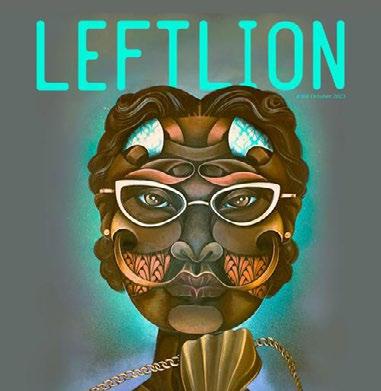

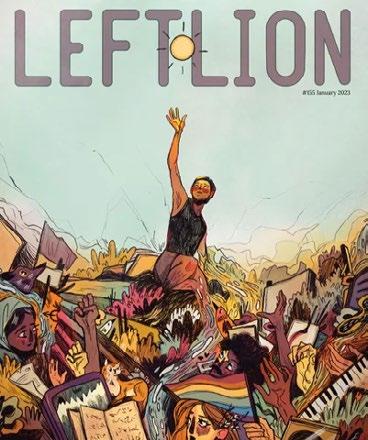
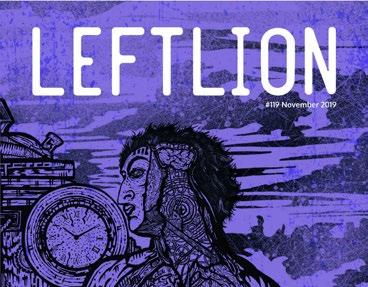



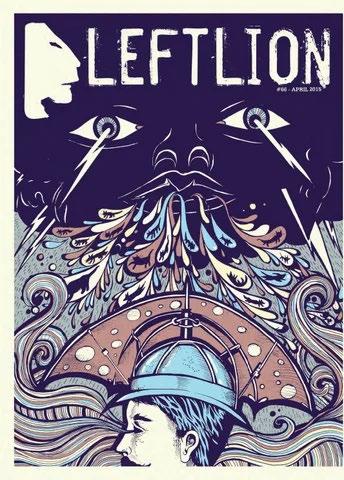




MAKE A NOTTINGHAM THEMED ZINE IN A DAY WORKSHOPS
words: Jay Sandhu and Zach Bromberg McCarthy illustration: Natalie Owen
Z APPLY] HERE OR VIA LEFTLION.CO.UK/WORKSHOPS
MARKET) Please note: this opportunity is aimed at 18 - 25 year olds in Nottingham
SUNDAY 5
| SATURDAY 11 MAY AT LEFTLION HQ (SNEINTON
BEST OF THE MONTH
Nottingham Puppet Festival
When: 9-21 April
Where: Various venues
How much: Various
A partnership between the Theatre Royal & Royal Concert Hall and City Arts Nottingham, first launched in 2018 with the 2024 festival being their third event. This year’s festival includes a whopping 60+ events over 12 days. Highlights include a talk by Ronnie Le Drew (aka Zippy from Rainbow) in conversation at Theatre Royal, a free family show by Handmade Theatre at Central Library and a finale event looking behind the scenes of The Sooty Show.

In Praise of Beauty
When: Until 4 May
Where: New Art Exchange
How much: Free entry
Artist Adébayo Bolaji delves deep to explore notions of beauty, question established norms and embrace more inclusive definitions of beauty in his latest showcase. As the exhibition title asks, what even is beauty? It’s something that artists, philosophers and scientists have spent many years pondering. For Bolaji the role of the artist is to ask questions. This exhibition is free and open from 10-4pm each day at the venue.
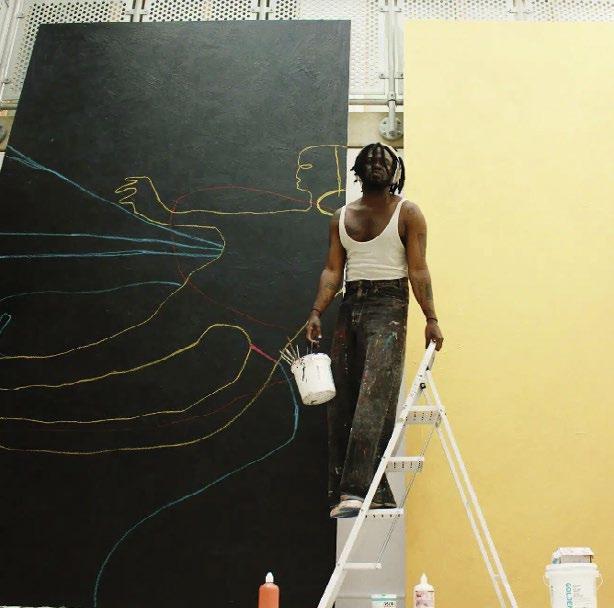
Bama Lama Sing Song
Where: Rescue Rooms
When: 12 April
How much: £11
Described as a night of ‘big grimaces, hugs, bad dancing, demonic voices and lots and lots of drunken hilarity’ Bama Lama is a perfect event for anyone who likes a bit of karaoke but doesn’t have the guts to get on stage solo. An epic night of live band singalongs that has become the stuff of legend and is a guaranteed good time for you and all your mates on a Friday night.

Juvenile In Justice
When: Until 3 November
Where: National Justice Museum
How much: Free entry
This exhibition explores the lives of young people living in prison in the USA. Blending photographs and first-hand testimonials, Richard Ross, whose work is celebrated throughout the exhibit, provides a unique insight into the lived experience and realities of more than 1,000 young people impacted by the justice system.

Sumac Centre 40th Anniversary Festival
When: 12-14 April
Where: Sumac Centre
How much: Various
The Sumac Centre is a volunteer-run social and community space based in Forest Fields. Although established in 2001, their work built upon that of the Rainbow Centre which ran from 19842001 at 180 Mansfield Road (hence the Ruby anniversary). Early pioneers of Nottingham’s environmental movement, this three day event will feature lots of music, veggie and vegan feasts, activism and more.
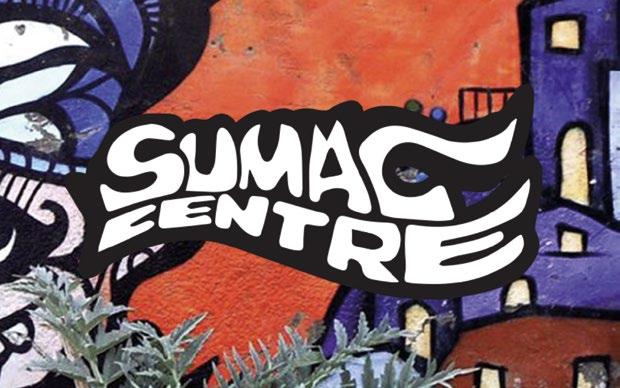
Beeston Film Festival
When: 23-28 April
Where: Arc Cinema (Beeston)
How much: Various
Now in its tenth year, the Beeston Film Festival has become something of a tradition for local cinephiles. This year for the first time they are showing full-length feature films curated around the theme of ‘Protest and Resistance’ including Suffragettes (2015), Made in Dagenham (2010), Mapantsula (1988) and The Old Oak (2023). However, shorts remain the backbone with 156 of them, from 28 countries, screening over six days.

Evolution Drone Light Show
When: 19 April
Where: Trent Bridge
Cricket Ground
How much: Various
Witness an epic-scale theatrical event told through a swarm of mesmerising drones flying in unison. Experience the sky above Nottingham as it becomes the stage for the story of human evolution. Watch the universe unfold, from the humble beginnings of single-cell organisms, to the awe-inspiring reign of the dinosaurs ending with the arrival of modern humans. Doors open at 7pm with the drones taking off around 9pm.

Cirque Du Soiree Variety Show
When: 28 April
Where: Metronome
How much: From £17
Be dazzled by a night of circus, burlesque, singing, magic and comedy with your fabulous host Lolo Brow. Catch world class acts such as Britain’s Got Talent juggler Steve Royle, hula hoop sensation Chi Chi Revolver, and aerial performer Rowan Grace, plus many others, and if it takes your fancy enjoy a pre-show dinner to make a night of it.

leftlion.co.uk/issue170 46

















































































 words: Adam Pickering
photo: Natalie Owen
words: Adam Pickering
photo: Natalie Owen




































 words: Andrew Tucker
words: Andrew Tucker





























